|
ADDRESS TO THE MEMBERS OF MADHYA PRADESH LEGISLATIVE
ASSEMBLY, BHOPAL
17-07-2006 : Bhopal
Missions for Madhya Pradesh's
Prosperity
Photographs
“When you are inspired by some great
purpose…
…Dormant forces, faculties and talents become alive.”
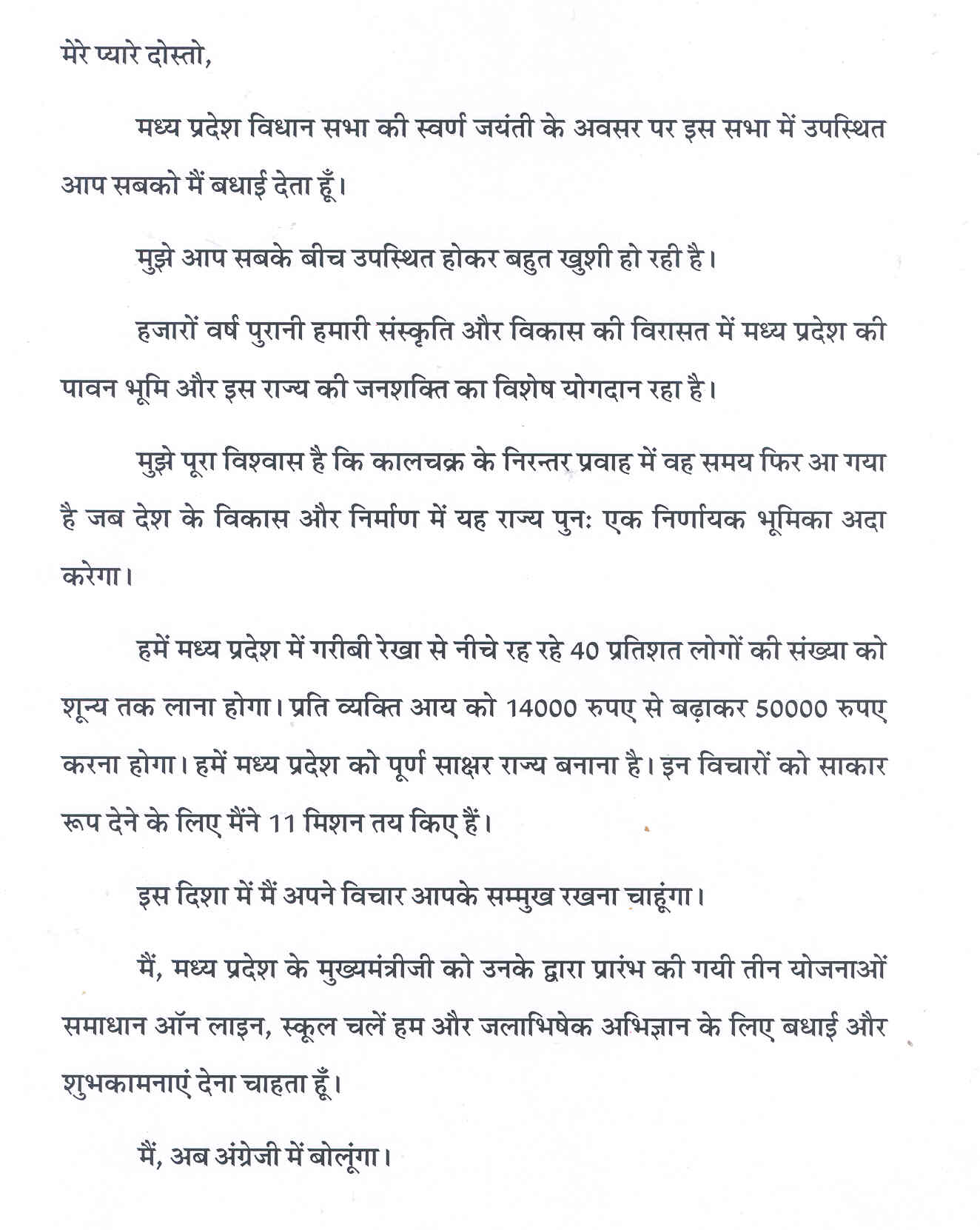
I am delighted to address the Honourble Members of the
Legislative Assembly of Madhya Pradesh. When I am with you, I am reminded of the
heroic deeds of the freedom fighters and nation builders of Madhya Pradesh like
Pandit Ravi Shankar Shukla, Pandit Sunder Lal Sharma and many others. The
members of Legislative Assembly of Madhya Pradesh belong to an institution that
gives vision to the State and evolves the legal framework, policies and
programmes of the State. You oversee the financial resources and implementation
of major tasks. Madhya Pradesh is the first State Government in India to change
from representative democracy to a fully elaborated system of direct democracy
at the village level. You have a proud history, your mission is to make the
aspirations and dreams of the people of Madhya Pradesh become a reality. My
greetings to all of you and to all the citizens of Madhya Pradesh in this Golden
Jubilee Year of the State.
My presentation to the Legislative Assembly on the occasion of the Golden
Jubilee Celebrations is based on the following principles :-
(a) Method of increasing the per-capita income of the State to Rs. 50,000 from
Rs. 14,000 by 2010.
(b) Improving the Human Development ranking of Madhya Pradesh from the present
12 to less than 5.
(c) Realizing the goal of total literacy before 2012 by giving highest priority
to women's education, particularly the tribal population.
(d) Empower all tribal citizens with quality education, healthcare and
employment potential.
(e) Progressively reducing the number of people living below the poverty line
from the existing 40 percent to near zero by 2016.
Madhya Pradesh and Me
The forests of Madhya Pradesh are well known to me. During
the period 1985 to 1995, I have moved from one area to another continuously for
many days with my team in Madhya Pradesh. That led to the establishment of an
important critical national facility in the forest region. That was the time,
when I interacted with very many tribal groups. Of course, some forest areas
where I had worked, are now part of Chhattisgarh.
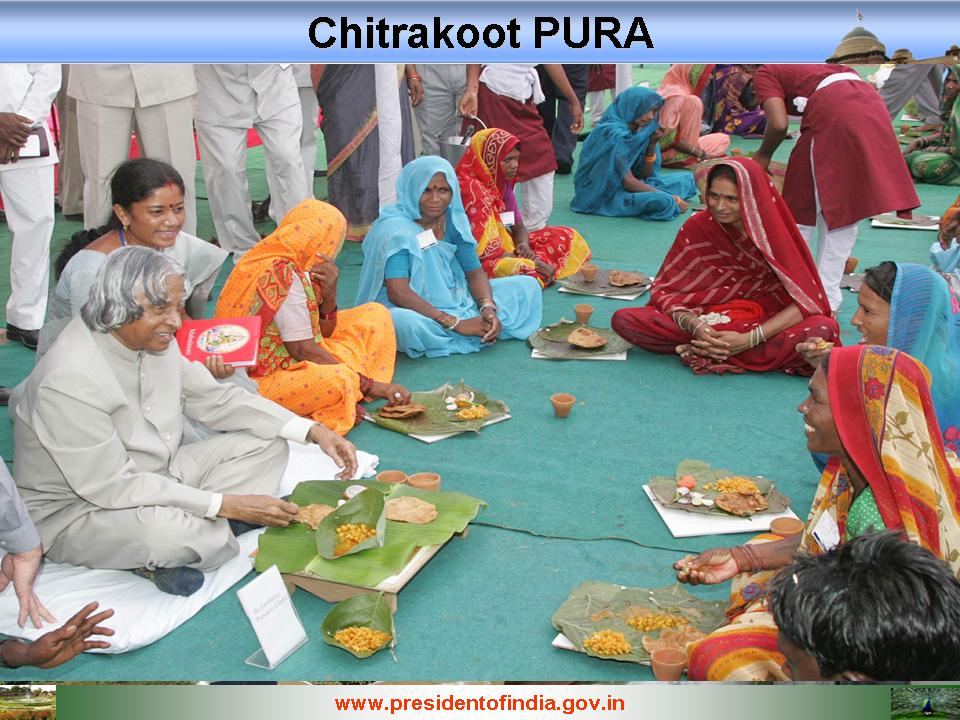
Dear friends, I recently visited Chitrakoot in Madhya
Pradesh, where I met Shri Nanaji Deshmukh, 90+ and his team belonging to the
Deendayal Research Institute (DRI). The DRI is a unique institution developing
and implementing a village development system, which is most suited for India.
As a part of integrated rural development, villagers are engaged in water
harvesting; effectively using it for cultivation of food grains, medicinal and
aromatic and horticulture cultivation. They are transforming herbs into herbal
products and marketing them. Apart from all these development activities, the
institute is facilitating a cohesive conflict free society. As a result of this,
eighty villages around Chitrakoot are almost litigation free. Villagers have
unanimously decided that no dispute will find its way to court. Differences will
be sorted out amicably in the village itself. The reason given by Nana
Deshmukhji is that if the people fight among each other they will have no time
for development. This is also true in the life of a nation in every political
system. The work of the DRI has enabled the generation of employment for a large
number of farmers in the Chitrakoot region. During my visit, I went to a small
village called Patni where the villagers talked to me about the progress of
their village and their problems. Many women said they have to send their
children long distances for studying beyond the 10th Class. They requested
upgradation of the school to the plus 2 level. They also felt the need for a
road which would connect multiple villages. The then Chief Minister readily
agreed and announced in the meeting itself, that school upgradation and the
provision of roads would be implemented immediately. I am sure that would add to
the happiness of many village farmers. The DRI understands that people's power
is very potent. Social advancement and prosperity are possible only by injecting
the spirit of self-reliance and excellence in the younger generation. Using this
principle the DRI has plans to develop a hundred clusters of villages having
approximately five villages each around Chitrakoot, based on the experience of
80 villages in 16 clusters. All these have been accomplished through the DRIs
"samajshilpi dampati" a new concept of counseling and intervention promoted by
the DRI as a well conceived societal mission.
I would like to share a few thoughts with the Honourable Members of this
Legislative Assembly on the topic "Missions for Madhya Pradesh's Prosperity"
with reference to the core competence of Madhya Pradesh and national vision.
Our National Mission – Challenges
Our nation is going through a major challenge of uplifting
220 million people who are below the poverty line. They need habitat, they need
food, they need healthcare, and they need education and employment finally
resulting in a good life. Our GDP is growing at nearly 8 percent per annum.
Whereas, economists suggest that to uplift the people from below the poverty
line, our economy has to grow at the rate of an additional minimum of 2 percent
per annum consistently, for over a decade.
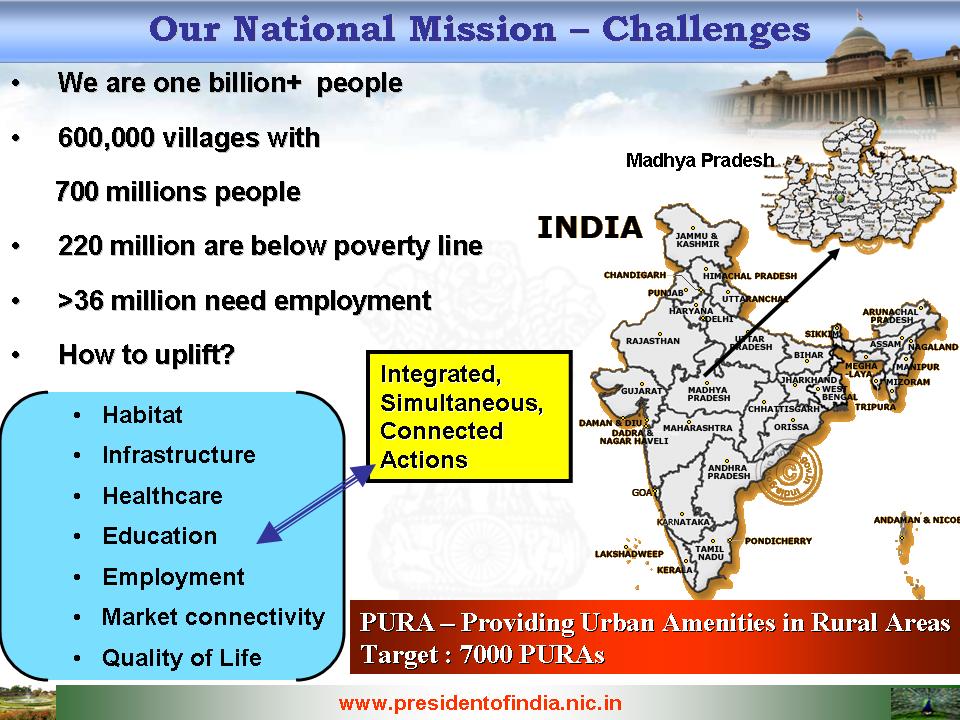
Integrated Action for Development
Our mission of transforming India into a Developed Nation is
to meet the needs of one billion people. We have identified five areas where
India has core competencies for integrated action: (1) Agriculture and food
processing (2) Education and Healthcare (3) Infrastructure for all parts of the
country such as reliable and quality electric power and surface and air
transport (4) Information and Communication Technology and (5) Self-reliance in
Strategic sectors. These five areas are closely inter-related and when
effectively addressed, would lead to food, economic, energy and national
security and lead to sustainable prosperity.
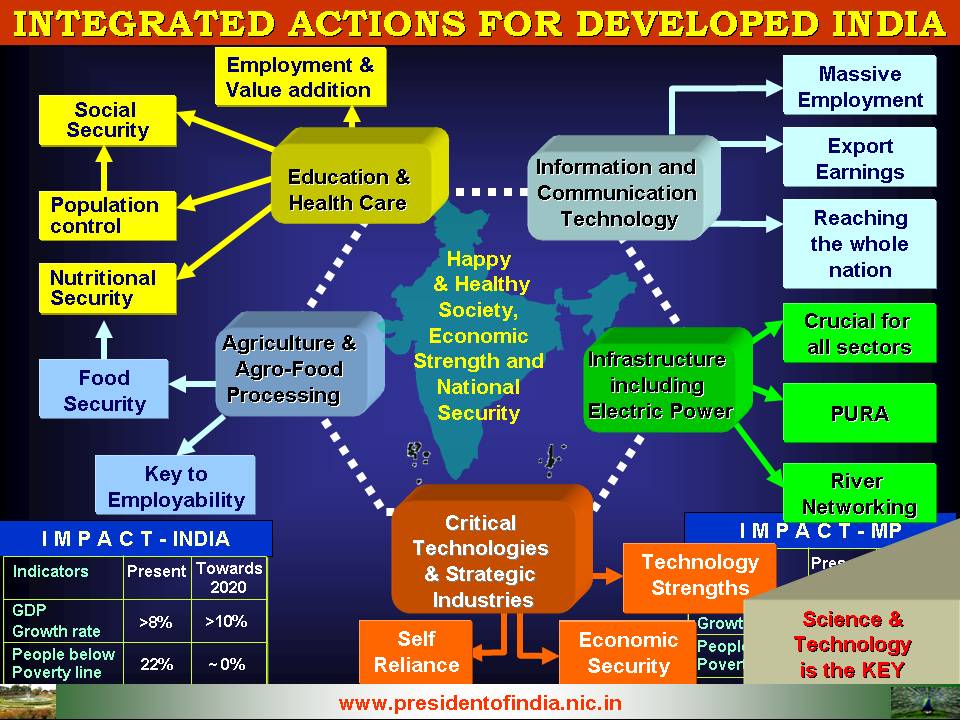
Engines for Growth
Emphasis should be on full utilization of natural and human
resources of the region to meet the demands of modern society. We should also
remember that about 50 percent of our population consists of young people, with
aspirations for a better life. This is also true in the case of Madhya Pradesh.
Value addition to agriculture, manufacturing and service sectors of the economy,
building on the State's core competencies and technologies, will lead to higher
incomes and employment opportunities and therefore higher growth rates. The
engines for growth will be the launching of the five national missions viz.
water, energy, education and skills, infrastructure and employment generation.
Developed states will result in a developed India.
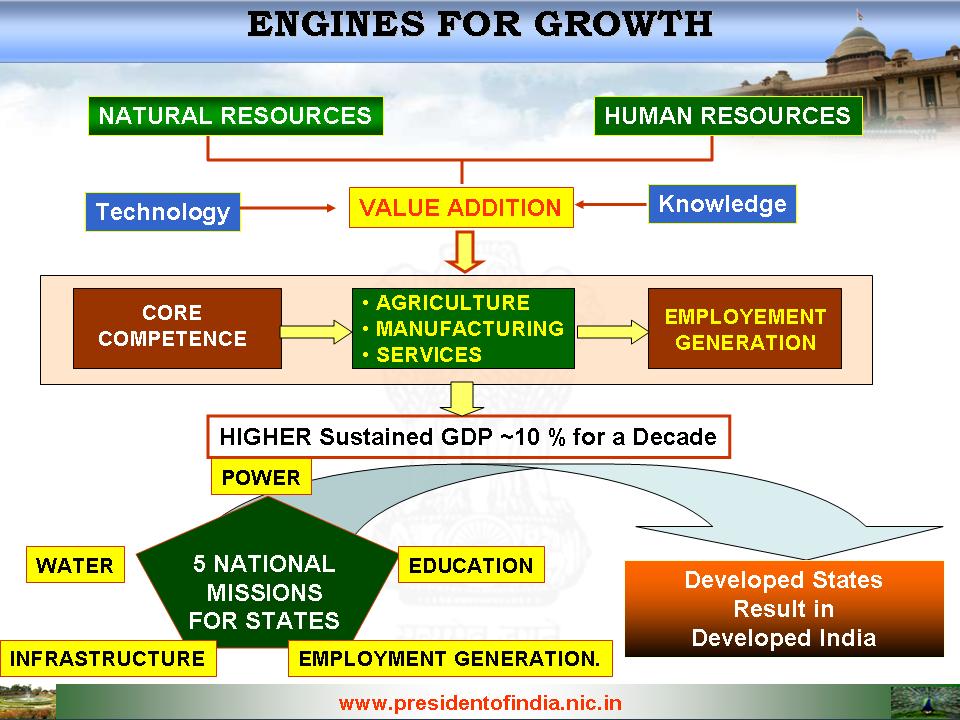
One of the questions that Members may ask is how can we
generate funds required for all the schemes, which I would like to share. I
would say that the Union Government has the Bharat Nirman Programme with an
outlay of Rs. 1,74,000 crore for the period 2006-2010, the Jawaharlal Nehru
National Urban Renewal Mission covering 63 cities with an investment of Rs.
17000 crores, the Employment Guarantee Scheme for 18 out of the 48 Districts of
your State and increase of bank credit for agriculture to Rs. 1,75,000 crore
during 2006-07.

Certain amount of fund have been allocated for the
development of Madhya Pradesh. The Honourable Members of this Assembly, and the
bureaucratic and the administrative system have to ensure that funds are sought
in time and are fully and effectively utilized for the purpose for which they
have been allocated.
Now, I would like to discuss the core competence of Madhya Pradesh.
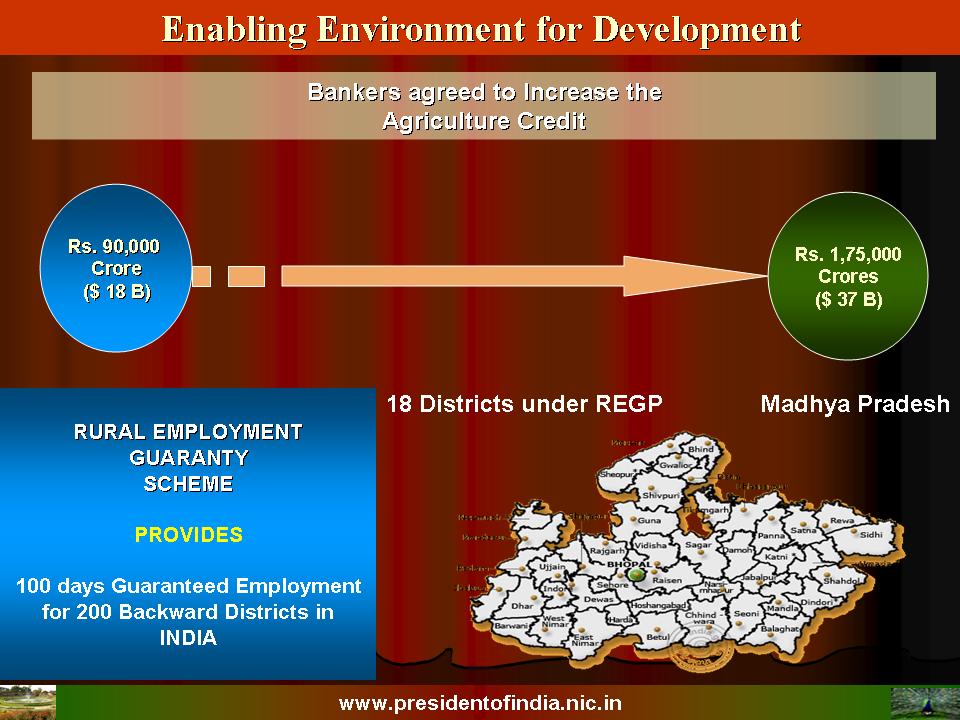
Core competence of Madhya Pradesh
Madhya Pradesh is the second largest state in terms of area
in the Indian Union. The total area of the State is 3,08,144 sq. km. The state
is completely landlocked. It straddles the Narmada River, which runs East to
West between the Vindhya and Satpura ranges; these ranges and the Narmada are
the traditional boundary between the North and the South of India. The State is
bordered on the West by Gujarat, on the Northwest by Rajasthan, on the Northeast
by Uttar Pradesh, on the East by Chhattisgarh, and on the South by Maharashtra.
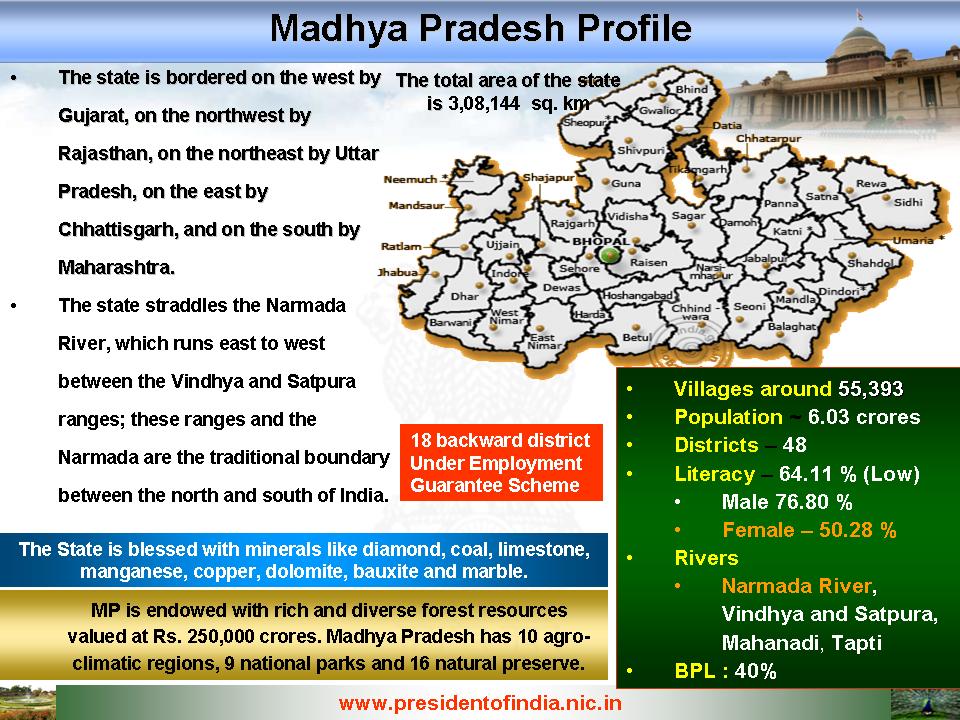
The importance of your State's water resource was noted by
many historians. In the center of India there exists a considerable highland
region with peaks and ranges. Several of the great rivers of our country have
their first source in this elevated region which pour their water into the sea
on either side of the peninsula - to the North the Son, to the East the
Mahanadi, flowing independently to the Bay of Bengal, to the South some of the
principal feeders of the Godavari, and to the West the Narmada and the Tapti
taking parallel courses to the Arabian Sea. Your State is blessed with minerals
like diamonds, coal, limestone, manganese, copper, dolomite, bauxite and marble.
I am sure the present and anticipated exploration activities will lead to large
scale extraction of mineral wealth of Madhya Pradesh.
Madhya Pradesh is endowed with rich and diverse forest resources valued at Rs.
250,000 crores. It has 10 agro-climatic regions, 9 national parks and 16 natural
preserves. The State is the largest producer of soyabeans, grams, oil seeds and
pulses.
Developed Madhya Pradesh leads to Developed India
What can be the mission to transform Madhya Pradesh into a
developed state? Since the number of people living below the poverty line in
Madhya Pradesh is about 40 percent against the present national average of 22
percent, the first mission should be focused towards development leading to
higher per capita income and better quality of life. Madhya Pradesh can
definitely transform itself into an economically developed model state. At this
stage, let me share with you the Development Radar brought out by the Planning
Commission.
The boundary of the octagon projected on the Development Radar indicates the
maximum achievements of various indicators of development. The smaller octagon
represents the national average. While we appreciate your achievements in
providing safe drinking water for half of your people, you need to achieve much
higher results in the area of pucca houses, literacy, formal education, life
expectancy, particularly infant mortality rate, per capita expenditure and
poverty alleviation. The Honourable Members need to realize that Madhya Pradesh
has the potential to achieve all these aspects by using the natural resources
and youth power available in the State and deciding to work in synchronization
for the development of the State as the prime mission of the Legislative
Assembly.
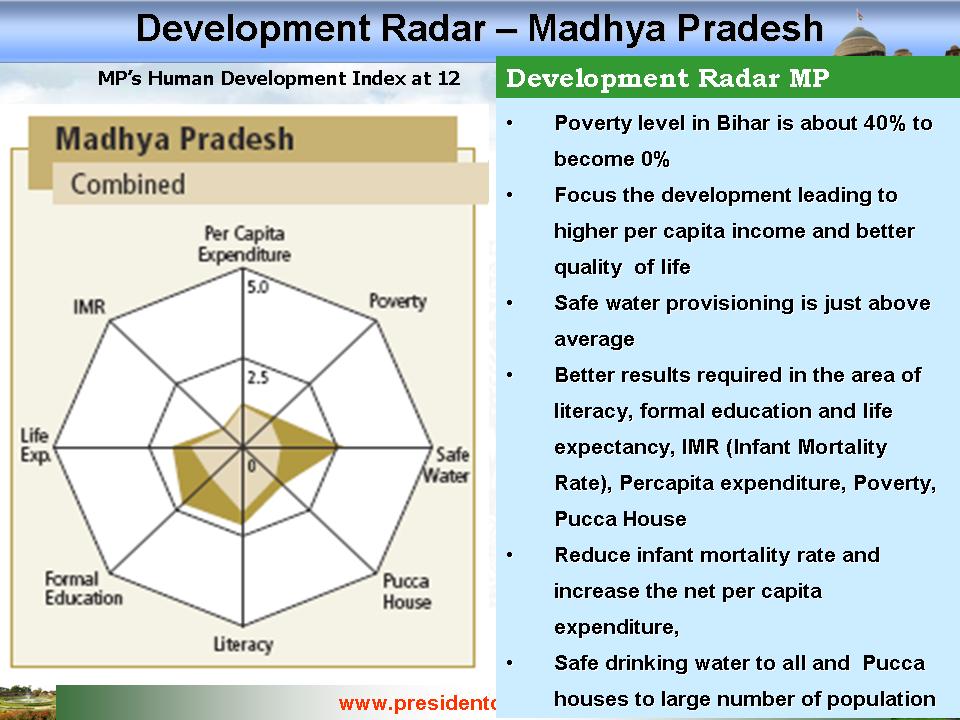
Missions for Madhya Pradesh
Let us study what are the missions which Madhya Pradesh can
undertake based on the core competence of the State. The following are some of
the important missions suggested for Madhya Pradesh’s prosperity :-
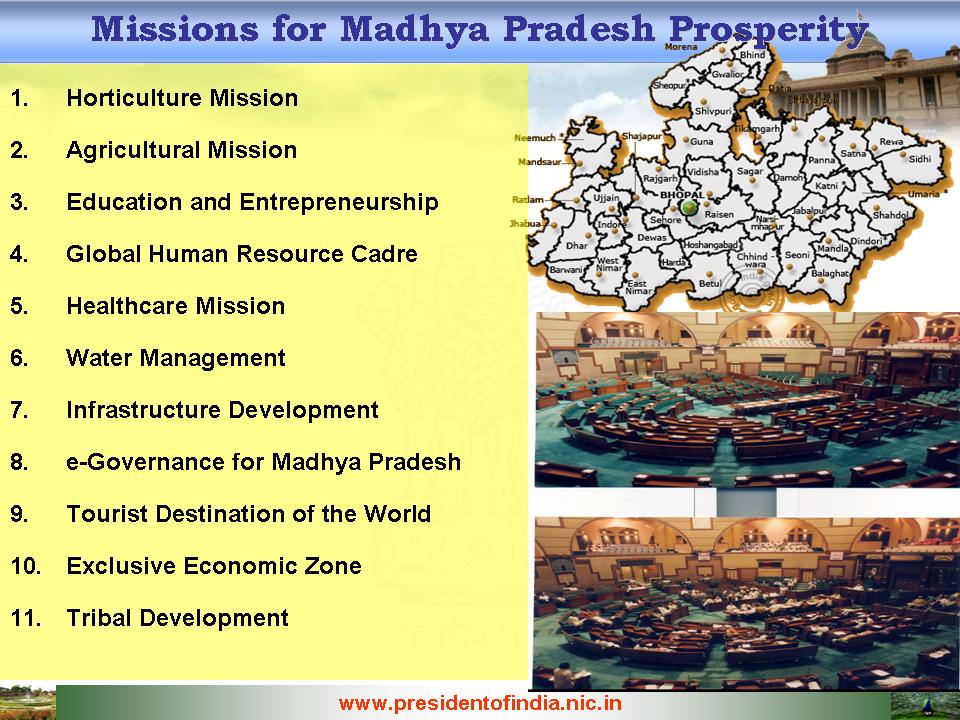
1. Horticulture Mission
While studying the horticultural programme of Madhya Pradesh,
I found that 18 out of 48 districts have been brought under the present national
horticultural mission. The rate at which horticulture is being introduced is of
the order of 15,000 to 20,000 hectares per year. I notice that land availability
for horticulture in Madhya Pradesh is around 20 lakh hectares.
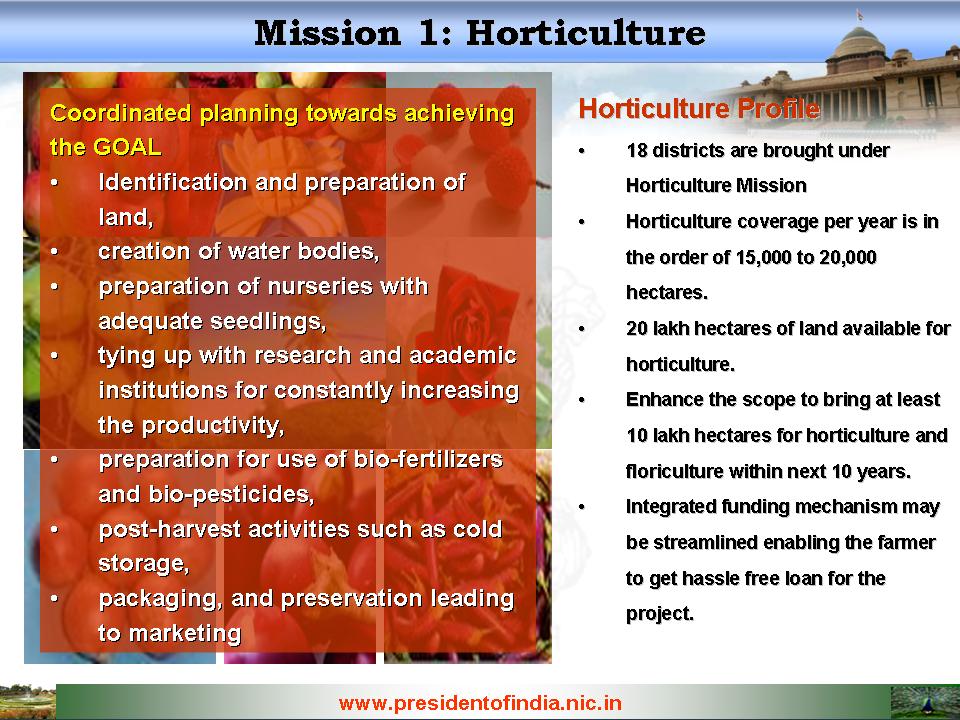
Potential for Horticulture: Considering
the potential of horticulture in Madhya Pradesh, it is suggested to enhance the
scope of the present mission to bring at least 10 lakh hectares under
horticulture and floriculture within the next ten years. This will need
coordinated planning towards identification and preparation of land, creation of
water bodies, preparation of nurseries with adequate seedlings, tying up with
research and academic institutions for constantly increasing productivity,
preparation for use of bio-fertilizers and bio-pesticides, post-harvest
activities such as cold storage plants, packaging, and preservation leading to
marketing. Presently, the Government is providing a subsidy of around Rs. 11,000
per hectare for the plantation and the other 50 percent is required to be
mobilized by the farmer. The integrated funding mechanism may be streamlined
enabling the farmer to get hassle free loan for his project.
Integrating Horticulture with Food Processing: While the
mission encourages farmers to go for horticulture and enhance their income there
is a need to integrate production activity with fruit and vegetable processing
which will provide larger value addition to the product and also prevent
distress sale by the farmer when faced with large quantity of fruits and
vegetables produce. These food processing units can be created as a co-operative
venture of farmers in different districts so that the benefits of value addition
will largely reach the farmer in addition to providing additional employment
opportunities. The average employment potential for a hectare of land for
horticulture is around four to five persons. In addition processing may provide
additional employment to one to two persons per hectare.
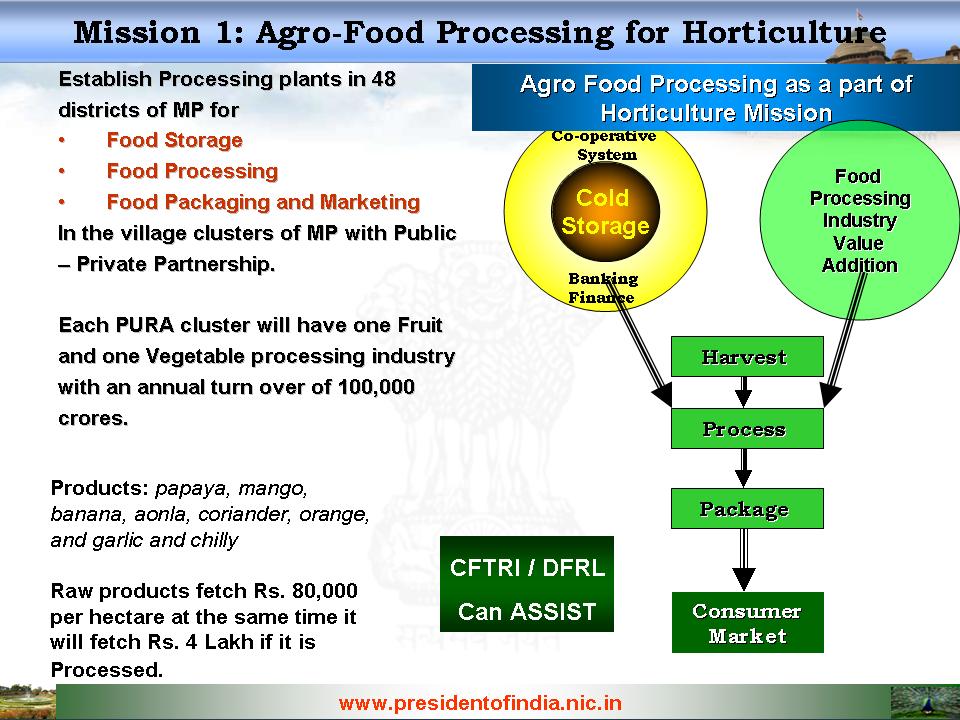
Food Processing as part of PURA: The
potential of the horticultural mission can hence be further enhanced by locating
fruit and vegetable processing units at a nodal center involving a cluster of
villages where fruits and vegetables are grown. These clusters can be provided
with physical connectivity, electronic connectivity and knowledge connectivity
as envisaged for a full-fledged PURA (Providing Urban amenities in Rural Areas)
which will facilitate vibrant knowledge based economic activity in the cluster
with potential for employment generation. The average value of produce depending
upon the type of product chosen such as papaya, banana, mango, orange, aonla,
coriander and garlic and chilly will be around Rs. 80,000 per hectare. The same
product once processed will have a value over Rs. 4 lakh. Hence, I would
recommend that the scope of the mission may be enhanced to include food
processing to become part of the mission and with a target of bringing one lakh
hectare per annum under horticulture products covering all 48 districts of the
State. When we bring one lakh hectares under the horticulture mission per year
it will lead to a revenue of Rs. 4,000 crore including food processing and
marketing and it will generate employment for 6 lakh people per year.
Outcome of the Project in ten years: When the entire 10 lakh
hectares are brought under horticulture the mission in 10 years will be able to
provide employment to six million people with an annual revenue of over Rs.
40,000 crore. As a part of the mission, it will be useful to establish links
with food processing research laboratories and horticultural research
laboratories which could eventually pave the way for the creation of
full-fledged laboratories in Madhya Pradesh. The corporate sector which has
created the “farm to fork” project in Punjab can also participate in this
mission. The State Government can provide a helping hand by simplification of
procedures, waiving of taxes and fees, speedy availability of existing
government or Panchayat land on attractive terms. With all the above concerted
steps, Madhya Pradesh could evolve as the horticultural hub of the country.
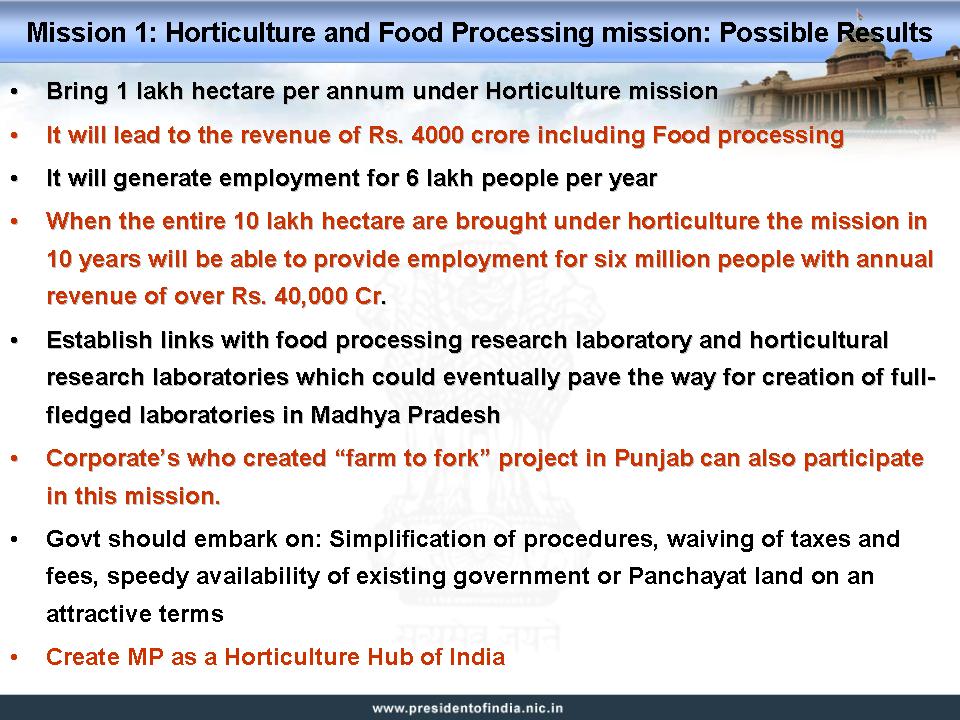
2. Agriculture and Related Missions
Agriculture is the core competence of Madhya Pradesh. It has
very good soil. Madhya Pradesh is basically rich in water resources barring a
few pockets. It would be possible to irrigate around 75 percent of the present
net sown area. The State should strive to double the irrigated area in the next
few years in partnership with the National Bank for Agricultural and Rural
Development (NABARD). I am happy that the State Government has signed a
tripartite MoU for development of one of the first of the 30 river linkage
projects conceptualized by the National Water Development Authority which will
provide irrigation facilities for an estimated 81,000 hectares. Using the
scientific method of farming involving soil characterization, matching the right
seed to soil, seeding in the right time, fertilizer and pesticide selection,
water management, pre-and-post harvesting methodology, productivity of the land
can be considerably increased. Our efforts should be to adopt an integrated
methodology of enhancing agricultural output in all 48 districts of the State.
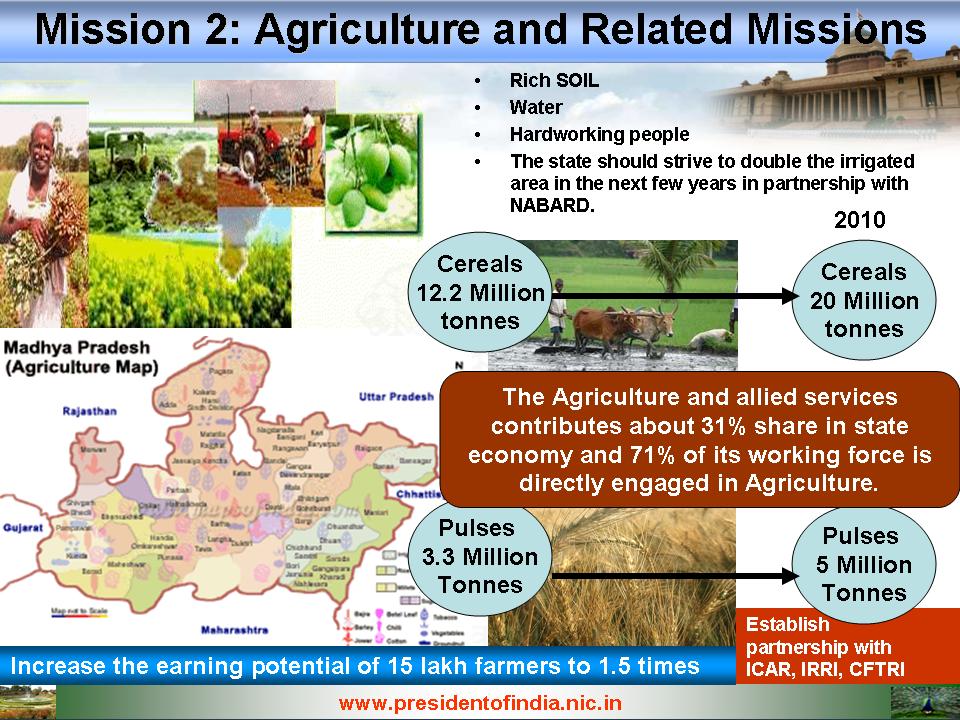
Strategies for Improving Production: The
aim should be to increase average production of cereals from the present 12.2
million tonnes to 20 million tonnes and pulses from 3.3 million tonnes to 5
million tonnes within the next four years. In order to achieve this target, the
factors which needs to be addressed are: State wide implementation of water
harvesting measures, reducing water-logging wherever it is, improvement in
infrastructure particularly good motorable roads, assured availability of power
to the farmer – through solar power; storage systems in large metric tonnes
capacities; food processing plants; input and output quality assurance centers
for seeds and food grains; matching the seed to the soil; and marketing centers.
Moving up the value chain in agriculture through food processing is essential in
Madhya Pradesh to increase the contribution of the agriculture work force to
Gross Domestic Product (GDP). This will result in increasing the earning
capacity of nearly 15 million farm workers of Madhya Pradesh by nearly Rs. 8,000
to Rs. 15,000 per hectare depending upon the chosen crop. A partnership is
essential with the Indian Council for Agricultural Research (ICAR), the
International Rice Research Institute, Manila, the Central Food Technology
Research Institute (CFTRI), Mysore and agricultural universities.
Soyabean Mission: Madhya Pradesh is the largest producer of
soyabeans in the country. Approximately, 5 million hectares are under soyabean
production spread in 44 districts. Our study indicates that average productivity
of soyabean in the State is around 1000 kg. per hectare as against international
productivity of around 3000 kg. per hectare. The International Crops Research
Institute for the Semi-Arid Tropics (ICRISAT) water shed team in partnership
with ICAR institutions and NGOs have worked in the State and found that the
average productivity of soyabean in Madhya Pradesh can definitely be increased
to at least 2000 kg. per hectare. This enhancement can be achieved through a
mission mode programme involving R & D agencies, agricultural universities,
industry, farmers and the government. The actions needed to be taken by the
mission are :-
(a) In many areas of Madhya Pradesh it has been found that the soil is deficient
in micro nutrients such as zinc, boron and sulphur. There is a need to map this
deficiency in different areas and bridge the gap through balanced fertilization
demonstrated on large farms. ICRISAT could provide technical assistance and
NABARD could provide financial support. Private companies who are processing
soyabean can also participate in this venture.
(b) Providing improved quality soyabean seed varieties to farmers in time for
sowing.
(c) Reducing rainy season fallows through knowledge campaigns and demonstration
to farmers and building their confidence.
(d) Promoting appropriate land and water management practices for alleviating
water logging and simultaneously harvesting water for subsequent supplemental
irrigation. This has to be done through demonstration in the region for
convergence and an integrated approach for enhancing productivity.
(e) Capacity building among stakeholders through training, skill development and
online problem solving and knowledge sharing through village knowledge centres
linked to Kisan Call Centres and PURA nodal centres.
(f) Arranging efficient processing of soyabean as soya oil, and soya protein
which can result in a value addition of 4 to 5 times.
(g) Rationalizing the import duty structure for soyabean oil similar to other
oils for making it remunerative for farmers.
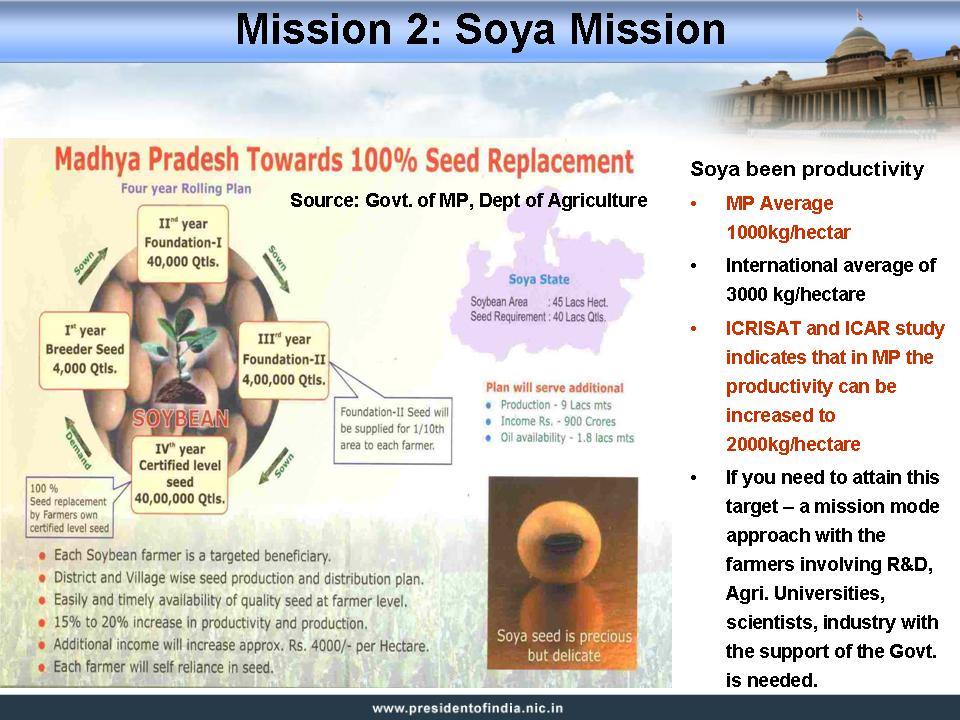
Management and Results: This mission can
be managed through the best practices followed in the co-operative model
available for milk products in Gujarat and sugarcane and sugar products in
Maharashtra. There is a potential to increase the total production of soyabean
from the existing 5 million tonnes to over 10 million tonnes. In financial terms
it will enhance the revenue of farmers from the existing Rs.4,500 crores per
annum to Rs.9,000 crores. This revenue increase will be available to 5 million
families owning 5 million hectares of land. Farmers' revenue will be further
increased through the commissioning of a “Chain-Soyabean” mission run by large
number of soyabean co-operatives supported by the Madhya Pradesh Government.
Krishak Mitra the selected progressive farmer of over 55,000 villages of Madhya
Pradesh can definitely play an important role in motivating other farmers in
their villages to work towards this goal.
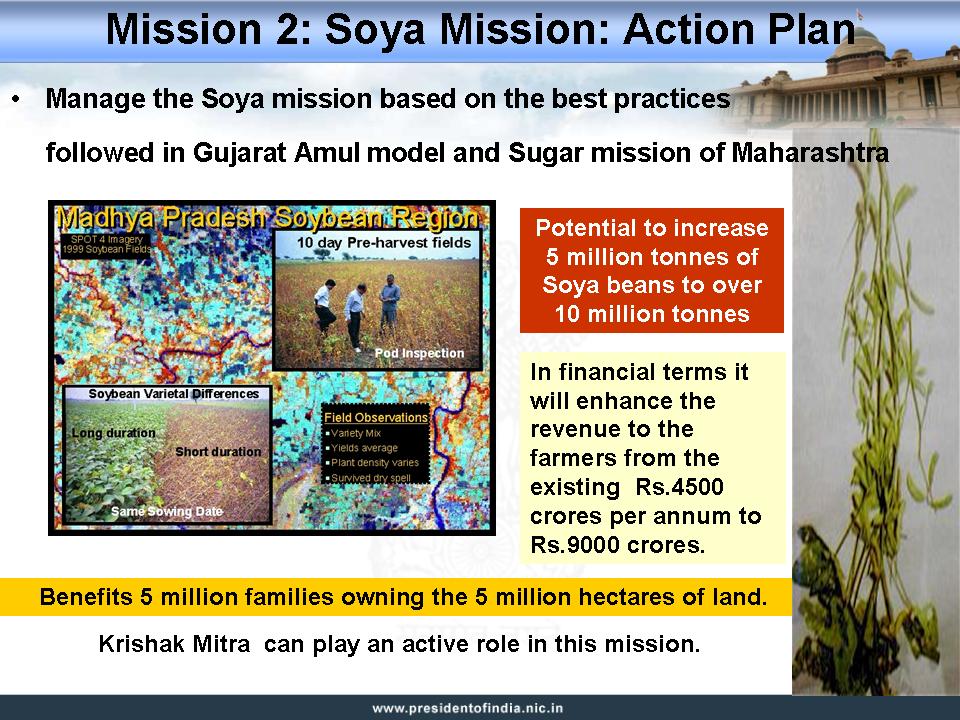
Dairy Development: Madhya Pradesh has a
successful model of dairy development through the Madhya Pradesh Dairy
Co-operative Society which has been established on the Anand pattern. Presently,
the society is procuring milk to the extent of 4.5 lakh liters per day. Over the
last three decades the dairy programme has expanded to 44 districts of the
State. The total members benefiting from this scheme is just 4.5 lakh. Dairy has
a great potential in Madhya Pradesh. We should attempt to improve the dairy
development programme by inducting high quality cattle followed by artificial
insemination and vaccination programmes. The aim should be to spread the
programme to all the districts and also to increase the participation of an
additional 5.5 lakh people over the next three years. This action will enable
the provision of additional productive self-employment to over five and half
lakh families in rural areas of the State over the next three to four years. As
already discussed, the Bharatiya Agro Industries Foundation (BAIF) has been
working on a programme of livestock development for promotion of dairy husbandry
in Jhabua district. This type of programme can be extended to other districts so
that the milk yield in the State as a whole is increased substantially so that
per capita availability of milk is gradually increased from the present 233
grams per day to at least 500 grams per day within the next five years. This is
essential to increase the nutrition content of the people especially mothers and
the children for reducing the infant mortality rate and maternal mortality rate.
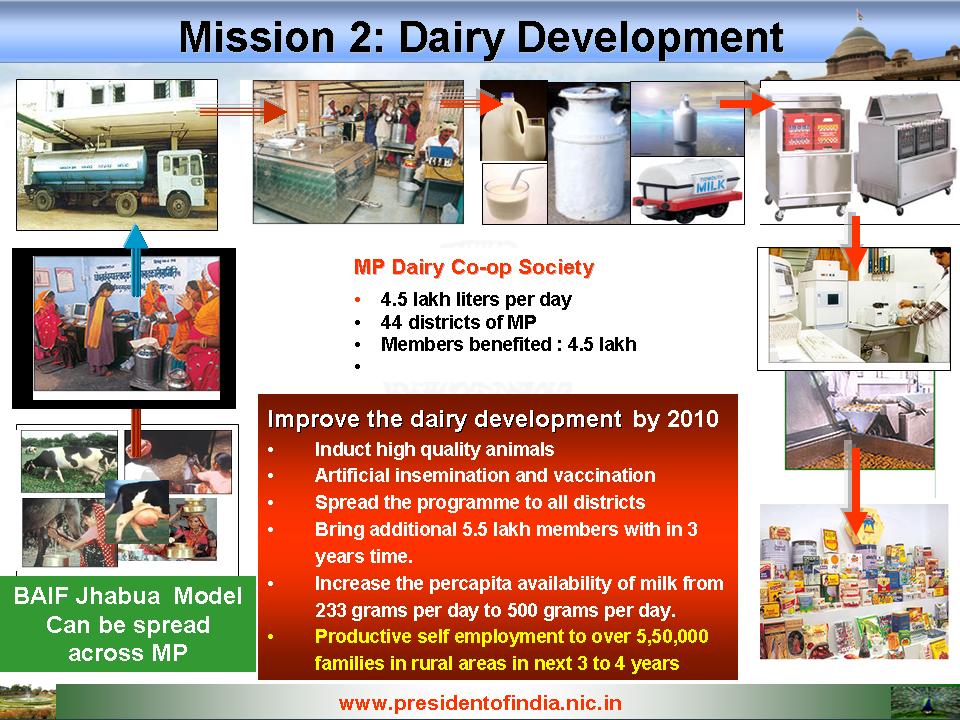
3. Education and Entrepreneurship
According to the 2001 Census, the literacy rate in Madhya
Pradesh was 63.7 percent with female literacy being only 50.3 percent. This
situation needs urgent remedial action. Firstly, there is a need to bring down
dropouts from elementary and secondary schools which is of the order of
35percent and 36 percent respectively.
Primary Education: Our aim is to develop human resources
with a value system and entrepreneurial skills. There is an urgent need to
arrest the tendency of school dropouts and the generation of happy enlightened
citizens. Some of the NGOs dealing with education should train children during
their formative years between three and five years in good habits, etiquette,
hygiene, creative learning and character building through a harmonious
educational atmosphere. Madhya Pradesh should apply this technique of
pre-education training in all the districts of the State. This is definitely a
societal mission. I have seen this type of training being provided by Dr. M.R.
Raju in Andhra Pradesh which has reduced drop out rates.
Secondary Education: Another model for secondary education
which I would like to suggest is the incorporation of accelerated learning
through computers which has been used in many government schools in Karnataka in
partnership with the Azim Premji Foundation. In this model reduction in dropouts
is being realized through active participation of parents, teachers and a social
organization in the region. This technique can be adopted in all the districts
of your State, so that drop outs at middle and secondary school level does not
take place. Madhya Pradesh may consider special training programmes for teachers
so that they can impart employable skills among children. These programmes can
be carried out both as direct contact programmes and as virtual learning
programmes to enable availability of teachers in the class without difficulty.
To remove adult illiteracy, a mission has to be taken by all children in higher
classes namely 9th, 10th and colleges to teach at least five persons every year
who cannot read and write. Such a multi-pronged strategy will enable Madhya
Pradesh to achieve at least 75 percent literacy by 2010 particularly among women
and cent percent literacy by 2015. The State Government may consider
introduction of mobile schools particularly in tribal areas for reducing
dropouts in addition to other interventions such as providing seasonal hostels
for students.
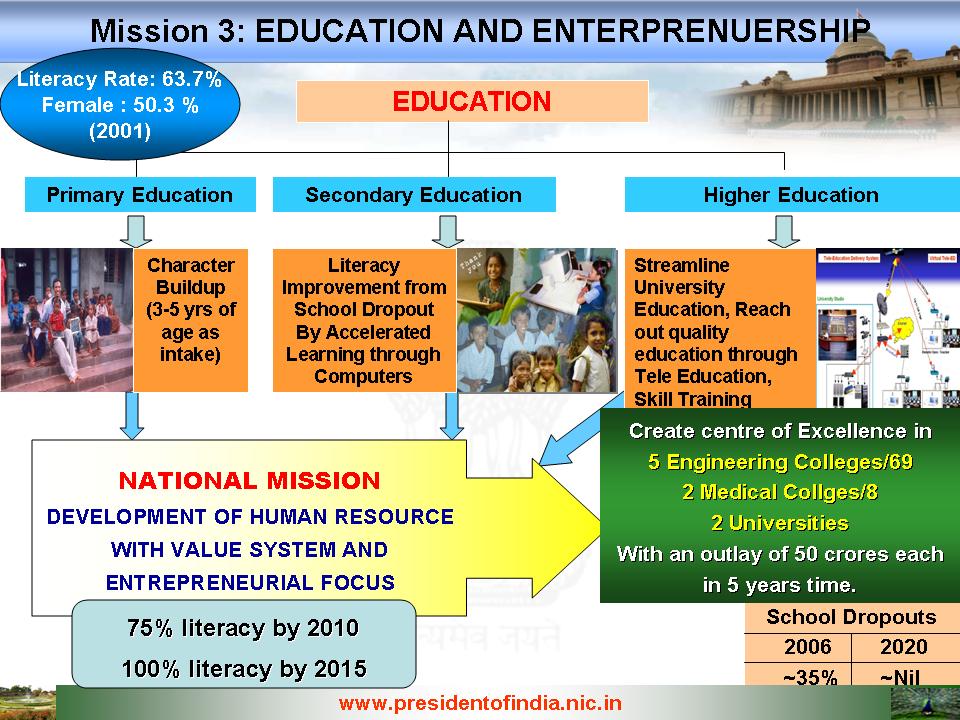
Institutions of Advanced Learning in Madhya Pradesh: The
Madhya Pradesh Government can consider selecting five engineering colleges among
the sixty-nine engineering colleges, two medical colleges among the eight and
two universities teaching arts, science and commerce and develop them as centers
of excellence. The budgetary requirement can be shared between the State Central
Governments. This approach will provide a benchmark for other colleges and
institutions in the State leading to qualitative improvement in higher education
as a whole. In addition, all Universities and their affiliated colleges in
Madhya Pradesh must progressively get themselves ISO certified. Similar to
higher education, centers of skill excellence can be created through the
upgradation of five polytechnics and ten Industrial Training Institutes (ITIs).
The Madhya Pradesh Government may also consider the establishment of a few
private sector advanced institutions at four or five key locations to provide
healthy competition for promoting excellence in education.
Entrepreneurship: Academic institutions in Madhya Pradesh
generate about 4.5 lakh graduates per year and 10th class and 10+2 students will
be around 10 lakh. Over 14.5 lakh youth will seek employment either within
Madhya Pradesh, outside the state or abroad. The school and university syllabi
have to be integrated with entrepreneurship courses in Madhya Pradesh. At the
end of the course students should get a certificate or a diploma. This will
enable students qualified in Madhya Pradesh schools and colleges, to have the
confidence that they can start small enterprises in agriculture, manufacturing
or service sectors based on the core competence of a particular region. Banks
have to be entrepreneur friendly and should give them venture capital and
support these young entrepreneurs and their creative ideas.
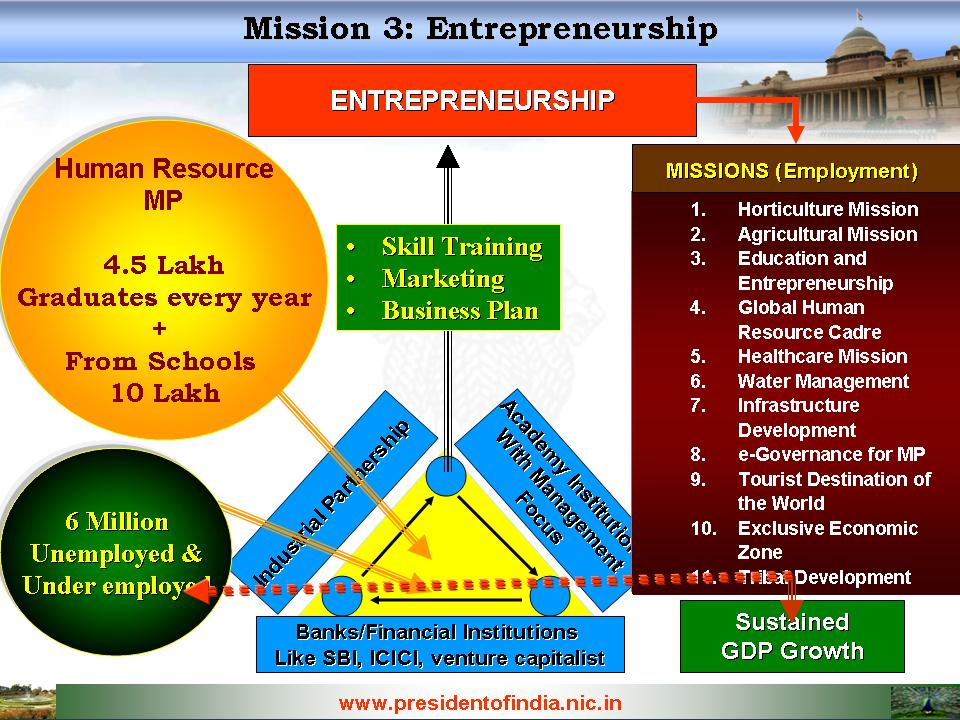
Venture Capital Enterprises: Venture
capital institutions are willing to participate in the development of the state
by developing small enterprises that can generate large scale employment
potential. You can invite the Chief Executive of some of the venture capital
institutions for working out an investment strategy for creating innovative
enterprises in your State and also popularizing the venture capital approach in
the State's development planning. Institution of this system will change the
situation in Madhya Pradesh by generating employment providers rather than
employment seekers.
4. Global Human Resource
As Members are aware, there is a need for quality human
resource in the country in all sectors of the economy namely agriculture,
manufacturing and services. Since there is a mismatch between availability and
the requirement of human resource, cost of hiring is going up, which is not
sustainable in the long run. We have to face this challenge and the higher
education system and the technical skill education system have to gear up to
generate manpower with employable skills in quantity and quality at all levels.
The education system has to be relevant to present day manpower needs and be
sensitive to global changes that are taking place in every sector of the
economy.
At present India has five hundred and forty million youth under the age of 25
which will continuously grow till 2050. In Madhya Pradesh alone, we will have
around 32 million youth. Keeping this resource in mind, universities and
educational systems in Madhya Pradesh should create two cadres: (1) a global
cadre of skilled youth with specific knowledge of special skills and (2) another
global cadre of youth with higher education to take up research and leadership
roles. These two cadres will be required not only for powering all sectors of
our economy but also to be a reservoir of knowledge for the rest of the world.
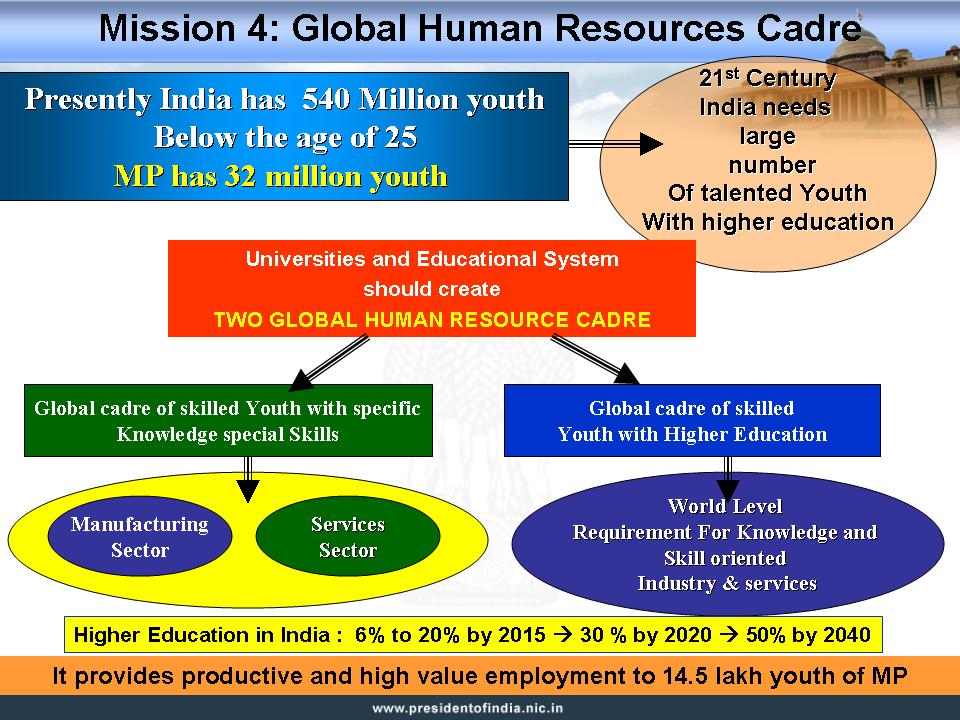
Universities, colleges and training institutions will have to
work towards increasing the through put of the higher education system from the
existing 6 percent to 20percent by 2015, 30 percent by 2020 and 50 percent by
2040. Youth who are not covered by the higher education system should all have
world class skill sets with quality workmanship in areas such as construction,
carpentry, electrical systems, repair of mechanical systems, fashion design,
para-legal, para-medical, accountancy, sales and marketing, software and
hardware maintenance and service, software quality assurance, craftsmanship and
tourism. No youth from Madhya Pradesh should be without either a world class
higher education or without world class skill sets. This is a mission that must
be undertaken by universities and colleges in the State. This will enable
provision of productive and high value employment to the 14.5 lakh youth who are
coming out of schools and colleges every year. At the Government level all
efforts should be made to remove shackles in the growth of educational
institutions by giving greater autonomy and removing controls.
IT Employment: As per the recent NASSCOM - McKinsey Report
2005, India has the largest talent supply for offshore IT and BPO. The IT and
BPO industry will be creating over 9 million jobs by 2010 exceeding the planned
employment creation across all special programmes of the State and Central
Governments. It will also create 6.5 million indirect and induced jobs to
support offshore IT and BPO industries in 2010. This will include employment in
several sectors such as construction, retail and transport. Power plus scenario,
nominal cost of living as compared to other cities, eco-friendly environment,
small commuting distances, peaceful atmosphere, reduced cost of land for
projects, the cities of Madhya Pradesh being located at the center of the
country gives the State an upper edge over other destinations for attracting IT
industries. The State Government has earmarked large tracts of land near
airports for establishing software technology parks in Indore, Gwalior and
Bhopal. The State Government can have an investors meet in Bhopal and present
the advantages which an IT company can get in Madhya Pradesh such as exemption
in taxation, single window clearance, exemption from obtaining prior approval
for setting up captive power plants by IT companies, greater transparency in
government transactions, and economies of operation. This approach should enable
your State to capture at least five lakhs direct jobs and another five lakh
indirect jobs by creating capacities and skills among educated youth through
specially organized programmes in collaboration with NASSCOM, CII, IT companies
and other social organizations in a mission mode. A well thought out
collaborative scheme is required for capacity building with national and
international partnerships.
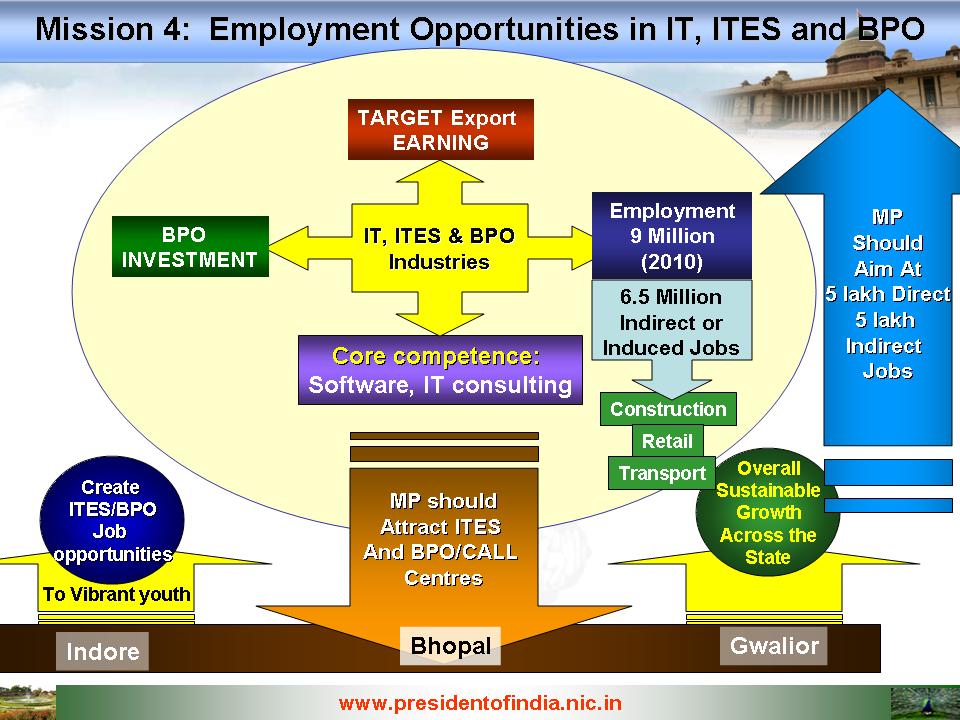
5. Healthcare Mission
Madhya Pradesh has 268 Community Health Centers (CHCs), 1153
Primary Health Centers (PHCs) and 8835 Sub Health Centers. It is important that
we make the PHCs fully functional so that inhabitants of rural areas can
benefit. These PHC’s, District hospitals can be equipped with mobile clinics,
which can reach remote areas. I would like to share an experience. Doctors
definitely have to be at the PHCs at least for three years or a contract can be
given to private corporate hospitals to run CHCs, PHCs etc.
Uttaranchal Mobile Clinic: On 19th October 2002, I
participated in the launching of a Mobile Clinic and Research Centre in
Uttaranchal. This effort was piloted by the Technology Information Forecasting
and Assessment Council (TIFAC), the Government of Uttaranchal, the Birla
Institute of Scientific Research and many other agencies. After 44 months of its
operation, I have found that this mobile clinic has been used in six districts
of Uttaranchal and has treated more than 50,000 patients have been treated
during this period. Among those treated, 48 percent belong to the Below Poverty
Line (BPL) category. Users are mainly from remote hill regions. The clinic has
provided 10,000 ultra sound, 6,000 X-rays, 2000 ECGs and nearly 20,000 lab
tests. The mobile clinic has documented the disease profile of patients in the
region (six districts) which falls into the following categories: acute peptic
ulcer, anemia, anti-natal, chronic obstructive pulmonary diseases, hyper
tension, pelvic inflammation, renal calculi, upper respiratory tract infection
and worm infection. This type of analysis has been possible because of a
computerized system of clinic management introduced right in the beginning.
Also, the mobile clinic has been used in regions which are normally inaccessible
and where organized medical facility is not available. This, I consider as the
best form of reaching healthcare to the neediest people.
This is a low cost solution with committed healthcare personnel and
institutions. Each district of Madhya Pradesh can have at least one mobile unit
to begin with. The clinical data provided by this model will be applicable for
many areas. Mobile clinics will also provide research input for certain diseases
prevalent in certain areas such as pulmonary edema and sickle cell. I understand
that there are already eleven mobile clinics in the State. The Government of
Madhya Pradesh can consider providing one mobile diagnostic-cum-treatment centre
in the remaining 37 districts of the state. This will become an important step
towards reaching healthcare to the people located in remote parts of the State.
These mobile hospitals can also participate in the immunization and control
programme against polio, tuberculosis, small pox, malaria and leprosy. In
addition Madhya Pradesh can make use of tele-medicine connectivity being
extensively used by institutions like Apollo, Narayana Hridayalaya, CARE
Hospital and other corporate hospitals for treating remote patients in
collaboration with the Indian Space Research Organisation (ISRO) for satellite
connectivity. I understand that a tele-medicine node is presently functional at
Gwalior. This should be extended to all district hospitals in the State.
There is a need to create specialty and super specialty hospitals near Tier-2
cities and district head quarters as public-private partnerships. These
hospitals can be connected to block level hospitals and mobile diagnostic units
through tele-medicine connectivities for making state-of-the-art medical advice
available particularly to people living in rural areas. There is also a need to
improve infrastructural facilities in existing medical colleges particularly in
the area of cardio thoracic surgery, neuro surgery, pediatrics and cancer
treatment.
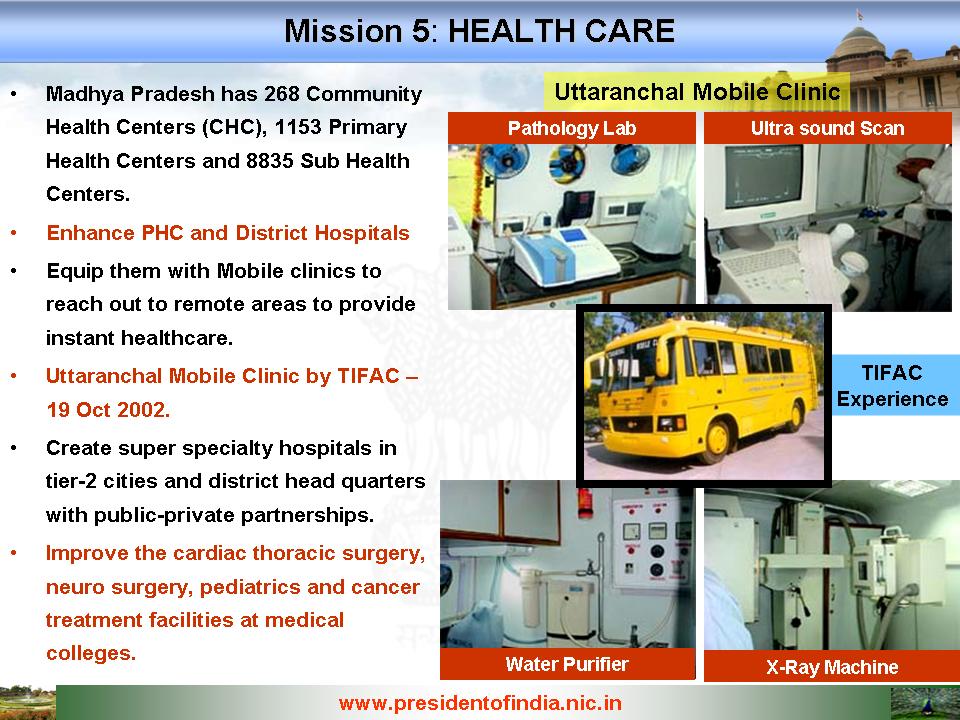
Yeshasvini scheme: I suggest a unique
insurance model for Madhya Pradesh, where health care will be available within a
short distance for each citizen. For providing comprehensive quality healthcare,
we suggest citizens make a contribution of about Rs.5/- per month per head and a
matching Government contribution of about Rs.5/-, which will lead to a
Consolidated Health Fund of Rs.720 crores per annum for the people of Madhya
Pradesh. The Government contribution will be only Rs.360 crores which will be
Rs.120 crores more than the expenditure for medical and public health incurred
during 2005-06. I would also recommend Madhya Pradesh to invite corporate
hospitals to set up super specialty hospitals supported by tele-medicine and
mobile clinics so that, they can not only provide quality healthcare but also
promote world class medical tourism in places like Pachmarhi. The State
Government can consider providing suitable incentives to corporate hospitals for
creating hospitals in different districts and becoming a partner in running the
healthcare scheme of the State for providing cost effective quality healthcare
to all the citizens of the State.
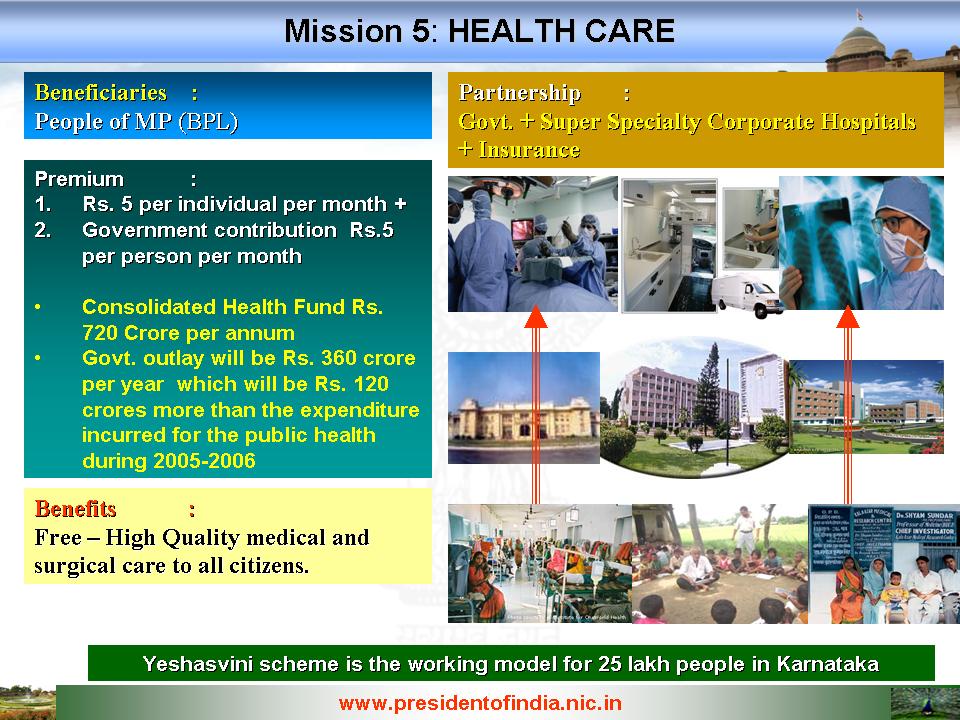
6. Water management
Madhya Pradesh has nine major rivers, namely Mahi, Narmada,
Tapti, Chambal, Betwa, Sone, Wainganga, Ken and Pench, which originate in Madhya
Pradesh and flow down to six bordering States, the estimated annual runoff from
these water sheds is over 80,000 million cubic meter, of which at least 50,000
million cubic meter can be harnessed for irrigation if some of these river
basins are intelligently connected. This will also contain the severity of
floods in some of these rivers during the monsoon months. Suggested action for
realizing effective water management of the state would be the following :-
(a) Recover all the water bodies from encroachments using satellite maps.
(b) All village ponds be immediately de-silted along with clearance of inlet and
outlet.
(c) Create additional water bodies in higher areas and fallow lands. This will
enable retention of water without being drained off to lower level villages of
the State and also enable farming operations to continue.
(d) Raise the protection wall for wells slightly above the normal flood water
level so that the debris does not fill the wells during floods and drinking
water is available immediately after the floods.
(e) Create additional check dams so that water can be retained in drought prone
regions of Madhya Pradesh.
(f) To protect cities create channelization, embankment and diversion channels
up-streams. Satellite data provided by ISRO may be utilized for planning and
implementing the overall water management system of the State. It is essential
that affected people of Narmada project are rehabilitated on a priority basis in
mission mode.
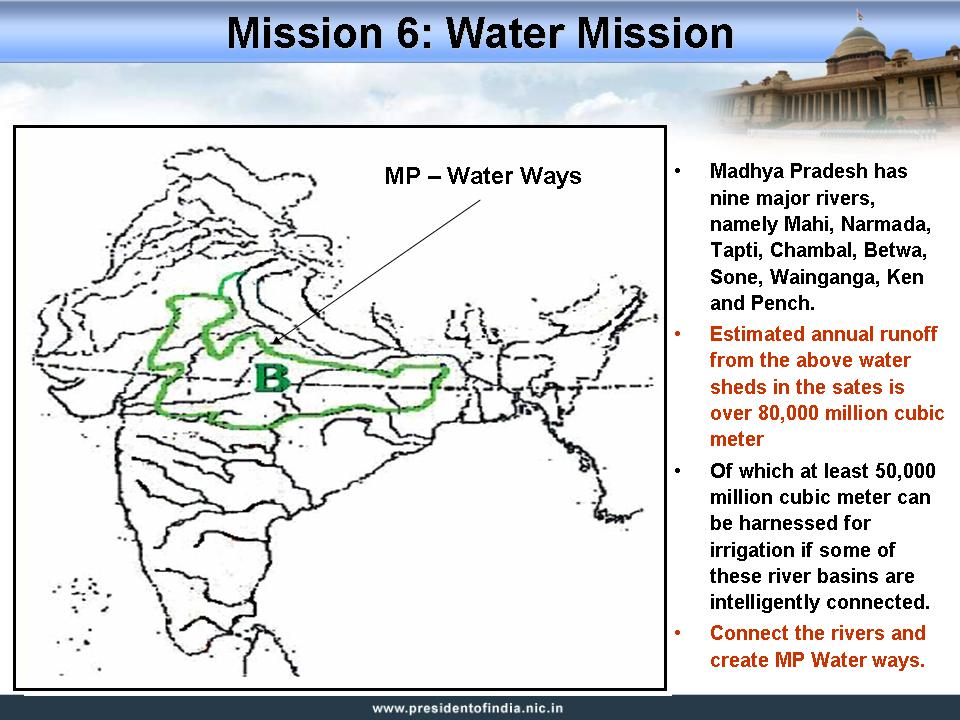
7. Infrastructure Development
Physical Connectivity: Madhya Pradesh has
a network of approximately 72,500 km of road network which includes 4600 km of
national highways. The all India density of roads is 24.5 km per 100 sq. km.,
whereas Madhya Pradesh has only 19.8 km. per 100 sq km. So far, 10600 villages
having a population of 1000 people have been connected through all weather roads
and 3400 villages having population of over 1000 are yet to be connected.
However, Madhya Pradesh has over 55000 villages. That means we have to ensure
good road connectivity for the remaining 41000 villages. While planning
connectivity for these villages, a PURA Cluster approach may be adopted. This
could be taken up as a part of the Bharat Nirman programme. I understand that
the Madhya Pradesh PWD and MP Rural Road Development Authority are taking up
provision of a good road network on priority. The aim of these two departments
should be to bring road density progressively to 30 km. per 100 Sq. Km. in the
11th plan period, either through Government or as a public-private partnership
venture.
This will definitely provide the needed mobility for economic development of the
rural sector in Madhya Pradesh. A good road network will be a win-win
proposition for all, especially for your State as it is placed geographically at
the centre of our country. Long distance road transport has to perforce pass
through Madhya Pradesh. As a result good roads will increase traffic and provide
a source of income for the rural people through spin-offs such as income
generated for the people through highway eating places and rest rooms. For the
nation, it would mean increased and cheaper commerce because of accessibility to
other parts of the country through Madhya Pradesh.
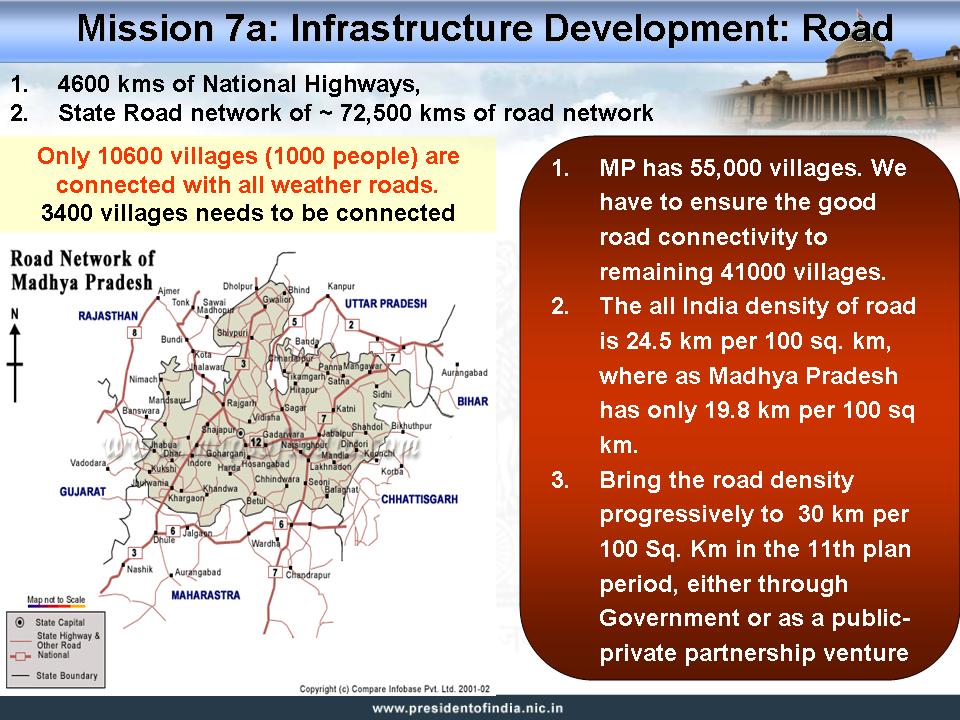
Establishment of PURA for Rural prosperity: When
a state's growth is driven by fast changing technologies, one must be cautious
about ensuring the participation of every citizen and region of the State with
out causing any technology or digital or economic divide. One of the solutions
for ensuring the homogenous and integrated development is PURA.
Madhya Pradesh has around 55,000 villages spread over 48 Districts and is
totally landlocked. Over 48 million people live in rural areas of your State.
Hence I would recommend the creation of approximately four hundred plain PURAs
for the entire State.
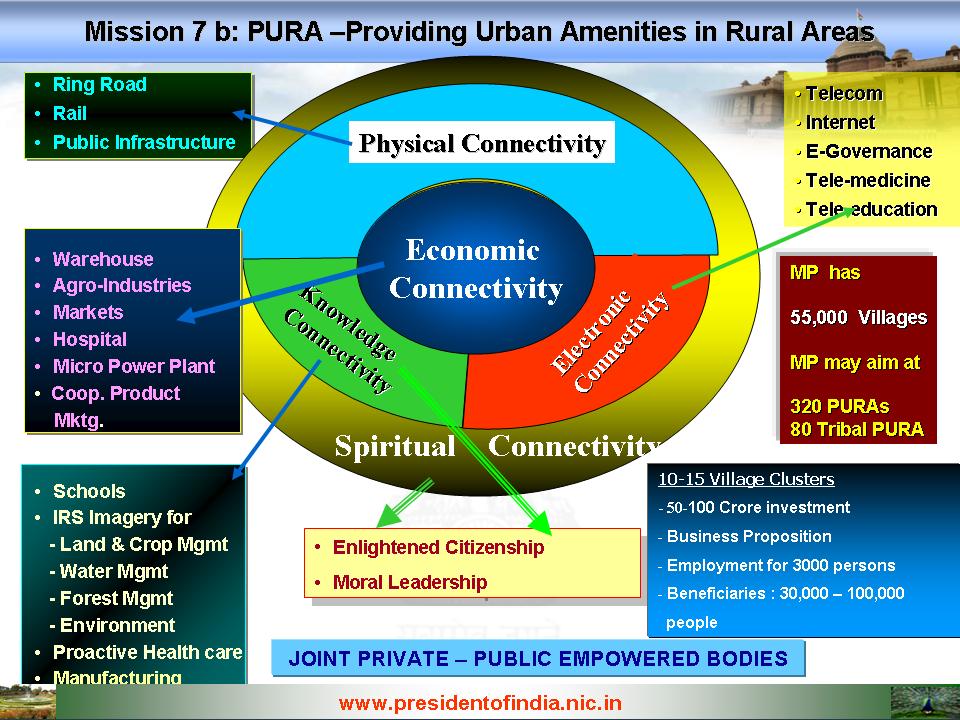
Essential Connectivities of PURA: The
integrated methods, which will bring prosperity to rural India are - physical
connectivity of village clusters having populations of around one lakh, through
quality roads and transport; electronic connectivity through tele-communication
with high bandwidth fiber optic cables reaching rural areas from urban cities
and through internet kiosks; knowledge connectivity through education,
vocational training for farmers, artisans and crafts persons and
entrepreneurship programmes. These three connectivities would lead to economic
connectivity through starting of enterprises with the help of banks, micro
credits and marketing of products.
After initial short-term employment during construction etc., we may have to
plan for initiating actions for providing regular employment opportunities for
10,000 people. If the industrial parks are marketed well, they can generate
employment opportunities in service and the support sector for about 30000
people. We need to promote entrepreneurship in rural areas. Each PURA should be
supported by one or more food processing enterprises and artisanal enterprises,
power loom, handloom enterprises, handicrafts and sericulture enterprises.
Indo-Japanese Collaborative Experience: As an example, I would like to mention
the handicraft promotion work taking place at Chhindwara and Seoni in Madhya
Pradesh, as a State Government, Central Government and JETRO of Japan
collaborative venture. Here the development of interior life style articles is
taking place with the intervention of JETRO technical experts. After prototypes
are made, the product is being sent to Japan for presentation in exhibitions for
getting a feedback. The feedback is used to further improve the product for
making it acceptable for sale in the international market. A similar model has
been followed between Thailand and Japan which has resulted in the development
of 26 products being produced in 26 villages with an annual turn-over of Rs. 300
crores.
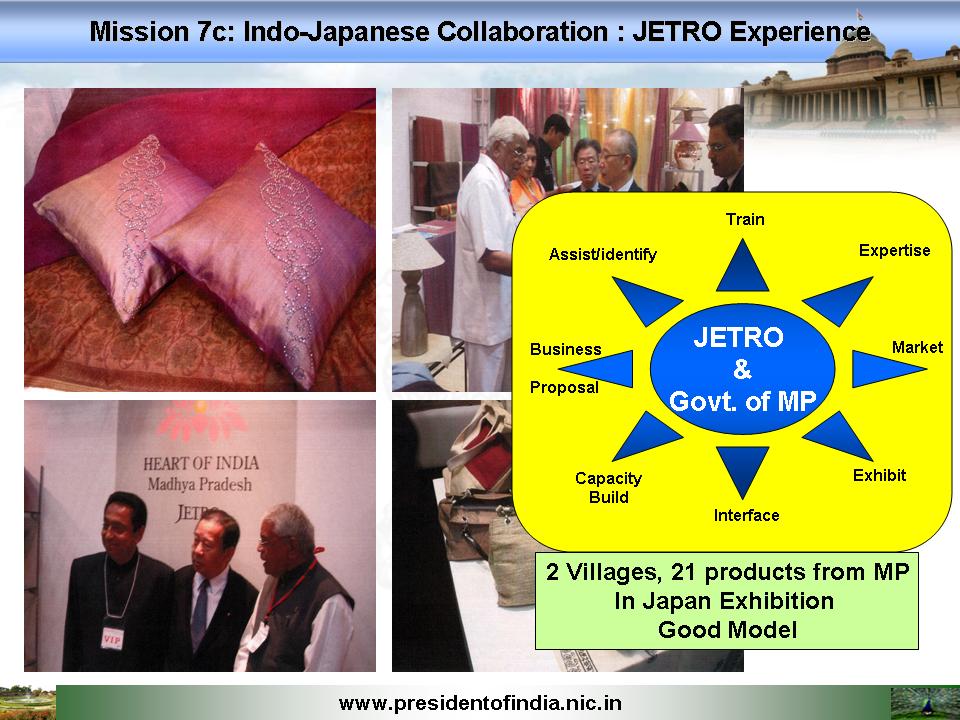
What is needed is application of technology for quantity,
quality and variety production of these products for servicing in the national
and international markets with management stewardship. The Institute of Fashion
Technology, New Delhi, National Institute of Design, Ahmedabad, Khadi and
Village Industry Commission can work with Rural Development Commissioners for
selecting and promoting products in the national and international markets. Each
village cluster depending upon the region will cost between Rs.80-100 crores.
The convergence of funding for PURA will come from the Bharat Nirman Programme
and other rural development programmes of the Central and State government
schemes for bringing sustainable rural development.
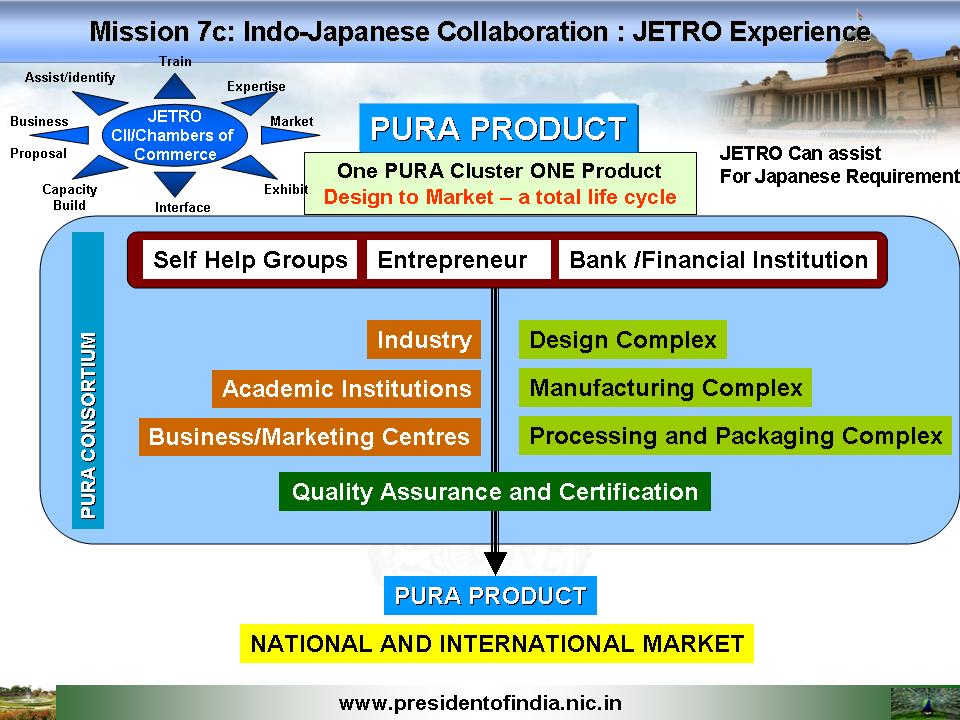
Power: I am happy to see that
infrastructure development in the state is taking place on a massive scale.
Presently, Madhya Pradesh has approximately 6000 MWs installed capacity
including power available from central sources. The State Government has plans
to bridge the gap of 2000 MW, between demand and generation capacity, which has
had an adverse effect on industry, agriculture and civic life. By 2008 Madhya
Pradesh will have a generating capacity of over 10,000 MWs and will become a
power surplus State. I understand that the State Government is in the process of
carrying out electricity reforms which will enable reduction of large scale
transmission and distribution losses. This is a welcome move. Over the last
three years the power sector performance has seen major improvement in Gujarat
both financially and operationally. There have been no power cuts or load
shedding. There has been no increase in tariff in spite of rising input costs.
The sector which was incurring a loss of nearly Rs. 1900 crores in 2003-04 is
showing a profit of Rs. 200 crores now in 2005-06. I am sure Madhya Pradesh can
definitely emulate this model. The emphasis should be on quality power with zero
interruption to all users including rural citizens.
I understand that out of the 55,000 villages in Madhya Pradesh only 1,713
villages located in remote areas are yet to be electrified. There is an urgent
need to electrify these villages using renewable energy sources on a priority
basis in collaboration with the Union Ministry of Non-Conventional Energy
Sources. Also, Madhya Pradesh must think of solar energy, wind energy, bio-mass
energy and generation of energy through municipal waste in some of the large
towns. These interventions will ensure that the State will be surplus in energy
at all times, since part of the energy for the State is coming from hydel
sources which has a low load factor during non-monsoon months.
8. Tourist destination of the world
Madhya Pradesh with a its large bio-diversity, rich heritage,
legendary pilgrimmage centres, scenic beauty and unparallel wild life should be
an important destination for tourists. Out of 382 tourist sites 18 major centres
attract a large number of tourists. However, it is important to make travel,
stay and the ambience of the tourist enjoyable. Madhya Pradesh has high
potential for international tourism. It is time to work out a strategy through
which new tourist circuits of interest are evolved in Madhya Pradesh, and are
made tourist friendly in all respects, so that they can attract many of them. In
that process there will be considerable income generation for the people of the
State at the grass roots levels. How do we achieve this?
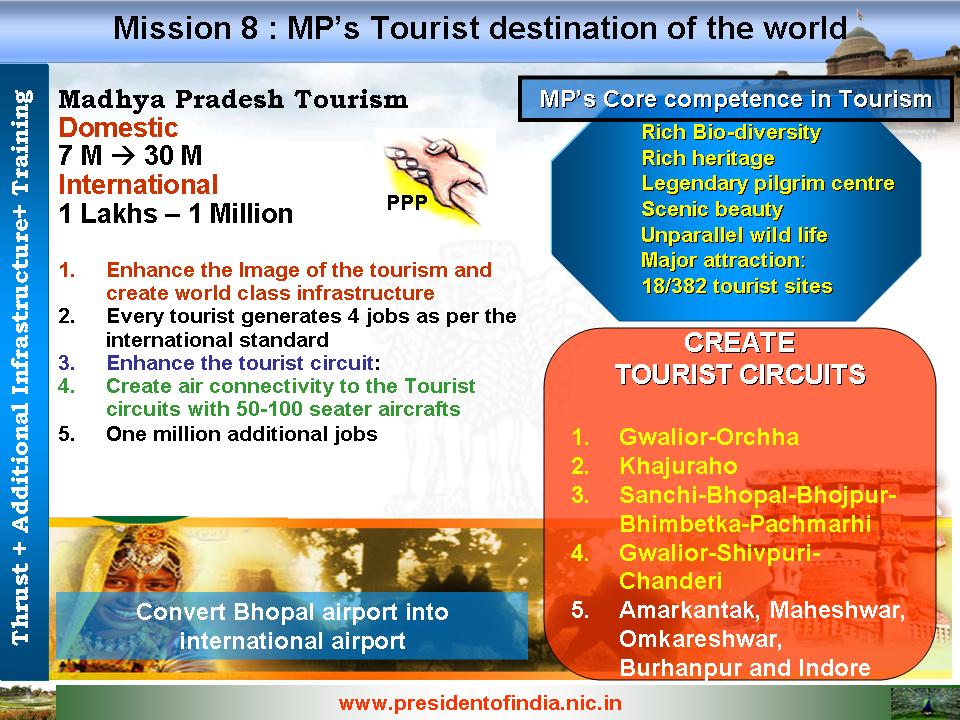
My experiences: when I visited Dubai, I
met the Ruler of Dubai. He told me that Dubai is planning to increase tourist
arrivals by five folds. Once this decision was taken, I found, that the aviation
minister was planning for a new airport and also new types of aircraft needed
for attracting tourists. The surface transport minister was planning a number of
additional road lanes required on highways. The works ministry was planning the
increase in hotel accommodations so that tourists could get bookings without
being disappointed. The health ministry had a road map for waste management and
a plan for providing additional clean water. This was the type of integrated
response that I found in the whole government to fulfill the national objective.
We have to take the message coming out of this experience and plan for multiple
requirements simultaneously for promoting tourism in our country.
Tourist circuits: Can we embark on such a mission in Madhya
Pradesh with an innovative public-private partnership? This will need a change
of thinking, mindset and action by the Union Ministry of Tourism, and the Madhya
Pradesh Government with the active collaboration of private enterprises. A
tourism development mission can be achieved only through multi-nodal ministry
participation with the single aim of making tourists have an enjoyable and safe
stay. There is a need for urgent development of tourist circuits:
Gwalior-Orchha, Khajuraho, Sanchi-Bhopal-Bhojpur-Bhimbetka-Pachmarhi and
Gwalior-Shivpuri-Chanderi. In addition, there is a need to develop Amarkantak,
Maheshwar, Omkareshwar, Burhanpur and Indore. A tourist circuit covering
heritage places in Madhya Pradesh has to be covered with air connectivity with
50 seater aircrafts to enable foreign and national tourists to get maximum
coverage in minimum time. There is a need to convert Bhopal Airport as an
International Airport to enable foreign tourists to come here directly. There is
also a need to upgrade many roads linking tourist destinations with four-lane
roads to facilitate faster road journey. In addition, we have to train people to
convert tourism into income generation such as providing special skills in
conversational foreign languages at nominal cost by the State through NGOs. Many
airlines are operating in the country now. The Madhya Pradesh Government can
initiate discussions and attract one or two airlines to use their services in
the prescribed circuit. In addition, perhaps some domestic commercial airlines
could be attracted to make Bhopal Airport the hub of their operations, once it
is upgraded to the level of an international airport, thus reducing operational
costs as Bhopal is geographically well placed. This would also perhaps take the
pressure off the other current hubs such as Delhi and Mumbai.
Growth in Tourism: These actions will enhance the arrival of
foreign tourists from the existing 1 lakh to over a million and also domestic
tourists from 7 million to over 30 million. Each tourist, particularly the
foreign tourist will create a minimum of two to three jobs in the transportation
sector, hospitality sector and other services. Vocational training institutes
have to create youth capacity, so that they can provide accurate information and
value added people friendly tourism services for national and international
tourists. These vocational training institutes can also create a pool of
manpower particularly for courteous taxi drivers, tourist guides and catering
service providers who would be able to render safe world class services that are
dependable and reminiscent of Indian hospitality and heritage. Tourism is a
multi-organizational mission which means Madhya Pradesh Government has to
initiate an empowered tourism mission. Tourism has the potential to convert
unorganized service sectors such as tourist transportation and catering to
professional organized levels and lift the living standards of the persons
employed in these sectors.
Public-private partnership: Treat investments in tourism as
a seed money for the development of Tourists Circuits in this region, but what
is needed is a mission mode operation involving public-private partnership
providing total services to the tourist in an integrated way with multiple
ministry coordination on the lines followed by the Maldives.
9. Exclusive Economic Zones
A method is required to be found for how investment can be
attracted in the State for the faster development in all the three sectors of
the economy. How can it be done? May I share a few suggestions with you? The
Madhya Pradesh Legislative Assembly may consider forming six Exclusive Economic
Zones. The suggested sites and products of these economic zones would be:-
Indore - Pharmaceutical, textile, IT and auto components
Pithampur - Apparel Park, jewellary Park and Herbal Park
Bhopal - Life science products
Jabalpur - Apparel Park and Stone Park
Rewa - Herbal Park
Sagar - Granite Park
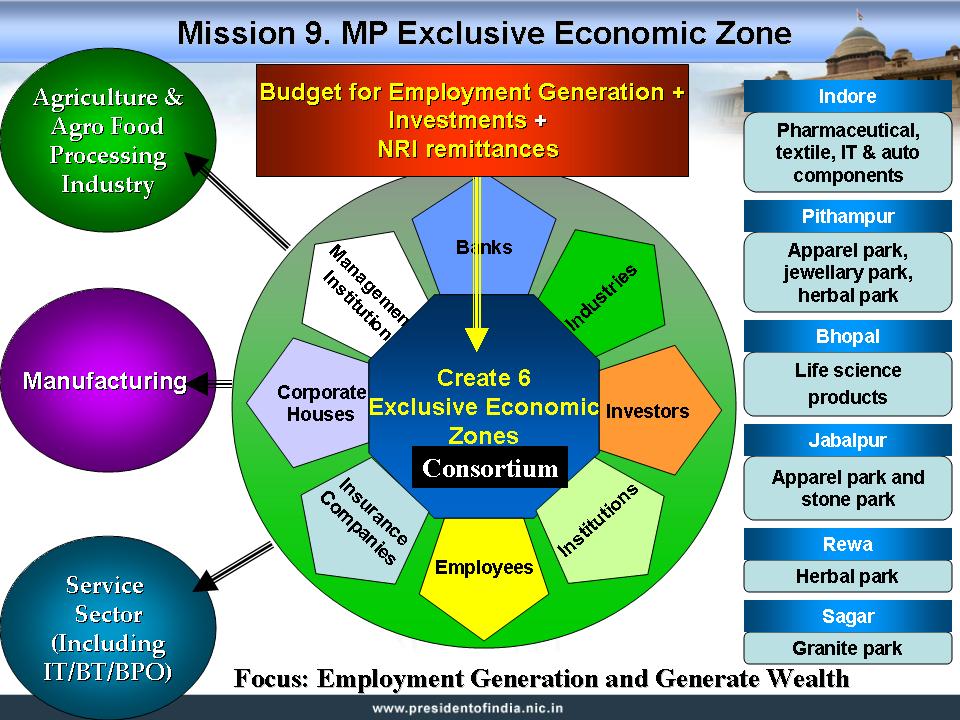
In order to build infrastructure and attract investment in
these zones, the Madhya Pradesh Government may consider the following actions.
(a) Fast single window clearance for attracting investment. (A multi-ministry
organization)
(b) Invite Madhya Pradesh origin industrialists and entrepreneurs who are within
the country and abroad for a meeting leading to the decision of taking up the
task of building and operating the Exclusive Economic zone in all three sectors
of the economy.
C) To provide land, power, water, physical and electronic connectivity to the
identified zones.
(d) Members of the Madhya Pradesh legislative assembly irrespective of party
affiliations will give an assurance for enacting proactive policies for ensuring
uninterrupted work culture in these Economic Zones.
(e) Employees have to be partners in these enterprises.
The State Legislature can invite prospective entrepreneurs to invest in these
Exclusive Eonomic Zones. The aim of the economic zone should be to qualify the
skill sets of the workforce to standards prescribed by the National
Manufacturing Competitiveness Council. The institutions must converge, and the
zone will have design, development, production and marketing capability. One of
the zones may be allotted for the development of a science city. Each economic
zone can lead to a turnover of Rs. 10,000 crores per annum.
10. e-Governance for Madhya Pradesh
Good governance is being recognized as an important goal by
many countries across the world. Madhya Pradesh has taken up specific
initiatives for transparent government. Freedom of information is being
redefined and supported by detailed guidelines. The internet revolution has
proved to be a powerful tool for good governance initiatives. An important
dimension of the internet potential is the possibility of providing services any
time anywhere. Along with this there is a conscious effort to put the citizen at
the center of the focus of governance. Citizens are being perceived as customers
and clients. E-governance has to be citizen friendly. Delivery of services to
citizens is considered as a primary function of government. Particularly in a
democratic nation of a billion people like India, e-Governance should enable
seamless access to information and seamless flow of information across the State
and Central Governments in our federal setup.
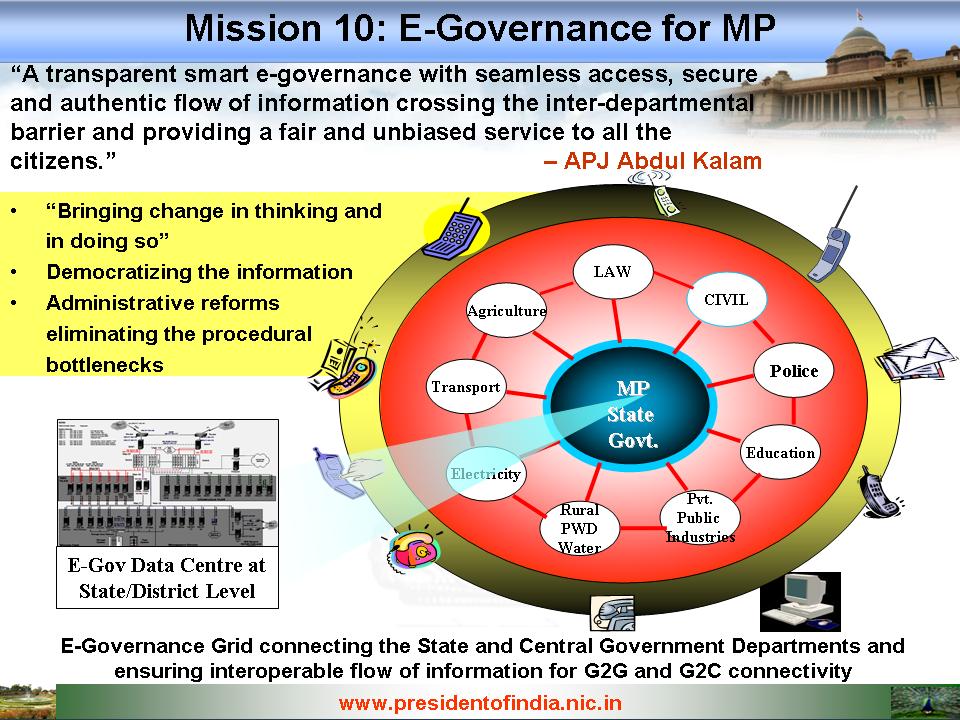
In summary, I visualize e-Governance as:
"A transparent smart e-governance with seamless access, secure and authentic
flow of information crossing the inter-departmental barrier and providing a fair
and unbiased service to the citizen."
Madhya Pradesh needs an e-Governance based accelerated management system to
administer finance and monitor and interface with Central and world
institutions. I would like to propose a system which should encompass seamless
G2G, G2C and G2B connectivity.

Now, let me share with you my personal experience in setting
up and operating a typical e-Governance Portal established at Rashtrapati
Bhavan. We have built an e-Governance system to study all correspondence,
letters and petitions on a day to day basis, analyze, prioritize, verify and
determine action requirements to be taken by Rashtrapati Bhavan and other
agencies in the government and relevant institutions both public and private. We
have now established almost a paperless, dynamic and secured workflow messaging
system for file movements within the department and inter-departmental
communications. We have established within Rashtrapati Bhavan facilities for G2G
and G2C connectivity and are in the process of establishing high bandwidth
broadband VPN connectivity with Central and State Governments and other relevant
institutions for seamless flow of information within the existing systems and
procedures of governmental functioning. This will soon become a part of the
e-Governance GRID. We will be very happy to share this experience and customize
a system needed for the introduction of a comprehensive system for Madhya
Pradesh's e-Governance (G2G and G2C).
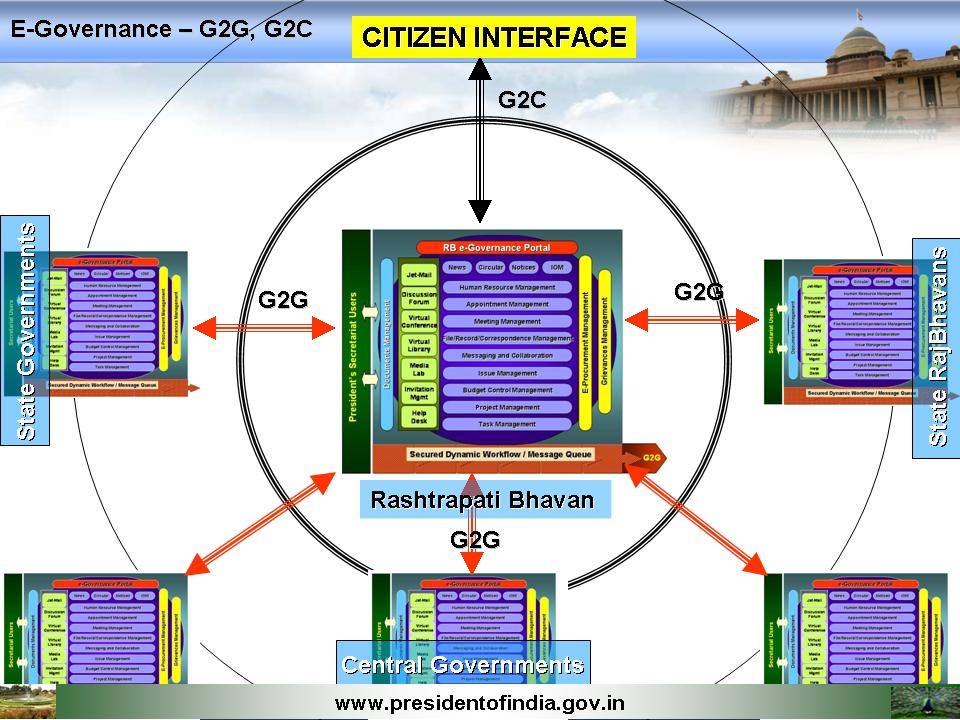
11. Tribal development
Presently around 23 percent of the total population of the
country resides in Madhya Pradesh. Tribal welfare is a priority sector for the
State Government. Besides, better health and the education facility in tribal
areas the State Government is promoting cultivation of medicinal plants and
processing of agricultural produce. Special health scheme have been formulated
for free transportation and medical facilities for delivery in hospitals.
Special provision also exists for recruitment in government service. There is a
need to preserve and nurture tribal culture. Since the tribal population in
general moves from place to place looking for new avenues for income generation,
I would suggest the creation of mobile health services, mobile schools and
mobile vocational training centres. I have already described a comprehensive
mobile health facility which can be replicated in this region. For mobile
schools and vocational training we require to transport teachers, teaching aids
such as blackboards, books, notebooks, computers and mobile shelters which can
be used for conducting classes. The idea should be to make education and
healthcare reach tribal citizens, wherever they are. This approach will ensure
training of tribal citizens in the skills required for pursuing revenue
generating schemes. Now I would like to discuss a model tribal development
taking place in Jhabua District.
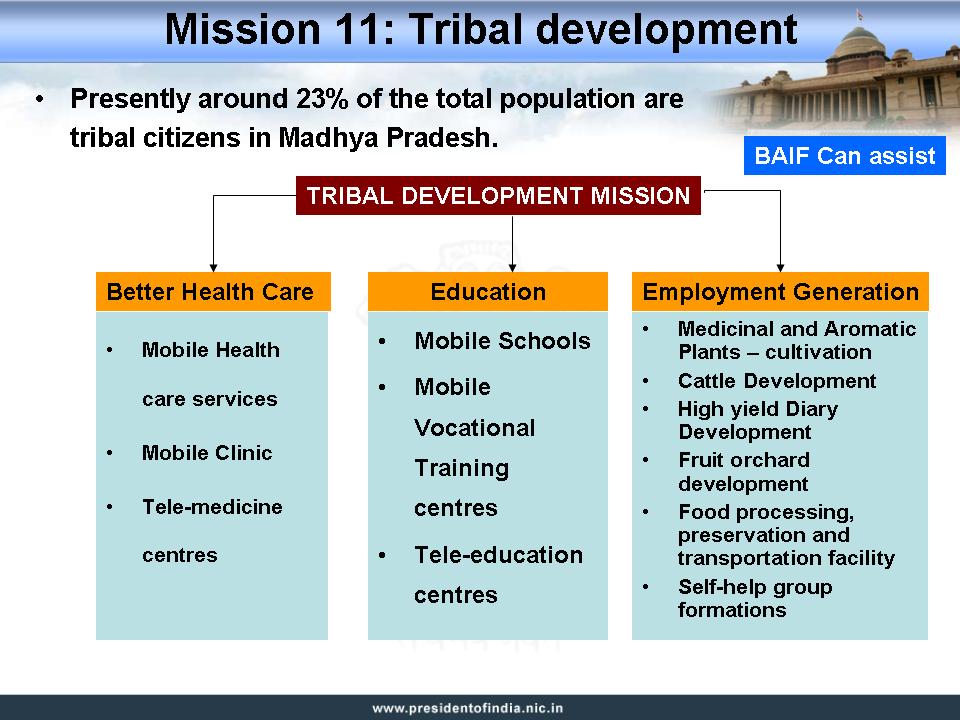
Model Tribal Development: I have studied
tribal development work being undertaken by (BAIF) in Jhabua and Hoshangabad
districts. There they have undertaken livestock development, watershed
development, handicraft production, fruit and vegetable processing and women
empowerment. This has substantially enhanced the earning potential of the tribal
population and improved their quality of life. Here the emphasis is on
livelihood development. It has to be enlarged to provide quality education and
health care. That will lead to a sustainable development model. I am sure there
may be many more models of this type in Madhya Pradesh. We can identify and
definitely replicate a holistic model in different districts for enhancing the
quality of life of the tribal people of Madhya Pradesh.
The eleven missions suggested for Madhya Pradesh can be
discussed in this Legislative Assembly for transforming Madhya Pradesh into a
developed state before 2015. Each of the missions that I have mentioned today
has the potential of making Madhya Pradesh economically prosperous with
tremendous effort coming from the political system, the administration and the
collective leadership of your State and the Center. The outcome of the mission
will be:-
Horticulture Mission: Generate employment for over six
million youth and an annual revenue of Rs. 40,000 crore by 2016.
Agricultural Mission: Increase output of cereals and pulses
from 15.5 million tonnes to 25 million tonnes in four years. Increase soyabean
revenue from Rs.4500 crores to Rs.9000 crores resulting in doubling of income
for 5 million families. Increase percapita availability of milk from 233 grams
to 500 grams in five years.
Education and Entrepreneurship: Realize 100 percent literacy
by 2012 and provide full employment to all 1.5 million youth passing out from
schools and colleges every year. Creation of Centres of Excellence in
engineering, science, arts and medicine.
Global Human Resource Cadre: All youth
will either have quality higher education or world class special skills. Madhya
Pradesh can capture five lakh direct employment and five lakh indirect
employment in the IT sector by 2010.
Healthcare Mission: Eradicate Malaria, TB and Leprosy in all
districts by 2012. Reduce the Infant Mortality Rate to 50 per 1000 and the
Maternal Mortality Rate to less than 5 per 1000. Reach quality healthcare to all
citizens including to tribal areas and enhance life expectancy.
Water Management: Harness additional 50,000 cubic meter of
water for irrigation. Create additional storage capacity through water
harvesting leading to a drought free Madhya Pradesh by 2012. Infrastructure
Development: Increase road density to 30 kms per 100 sq. km., plan for 400 plain
PURAs, create the "one village one product" model to generate revenue of Rs.10
crores per village.
e-Governance for Madhya Pradesh: Create a transparent
citizens friendly, investment friendly atmosphere leading to a prosperous and a
happy State.
Tourism Destination of the World: Increase
international tourism from 1 lakh to one million and domestic tourism from 7
million to 30 million creating nearly 3 million jobs in the next five years.
Exclusive Economic Zone: Creation of six Exclusive Economic
Zones to enable balanced economic growth of the State. Each economic zone can
lead to a turnover of Rs. 10,000 crores per annum.
Tribal Development: Provide quality education, quality
healthcare and productive employment opportunities to over 14 million tribal
citizens of the State.
Dear Honourable Members, I have put forth in front of you, 11 missions for the
prosperity of Madhya Pradesh. You may ask questions, give suggestions, I would
like to respond. I will be very happy to correspond with you on Madhya Pradesh
related development. Let me finally give a suggestion for your consideration.
All of you might like to ask yourself a question? "What will I be remembered
for?" If each one of you asks yourself "What will I be remembered for?" What can
be your response? The response of course, as you are nurtured in the cradle of
Madhya Pradesh, definitely your heart and mind will say I will work in my
lifetime, to be a partner in making Madhya Pradesh "an economically prosperous,
happy and safe State". I believe that the 11 missions, which I have described
today can be the foundation for the mission of Madhya Pradesh's prosperity
leading to the creation of Madhya Pradesh as a great State.
My best wishes to all the Honourable Members of the Madhya Pradesh Legislative
Assembly and the people of Madhya Pradesh success in their mission of
transforming their State into a developed State by 2016.
May God bless you.
|